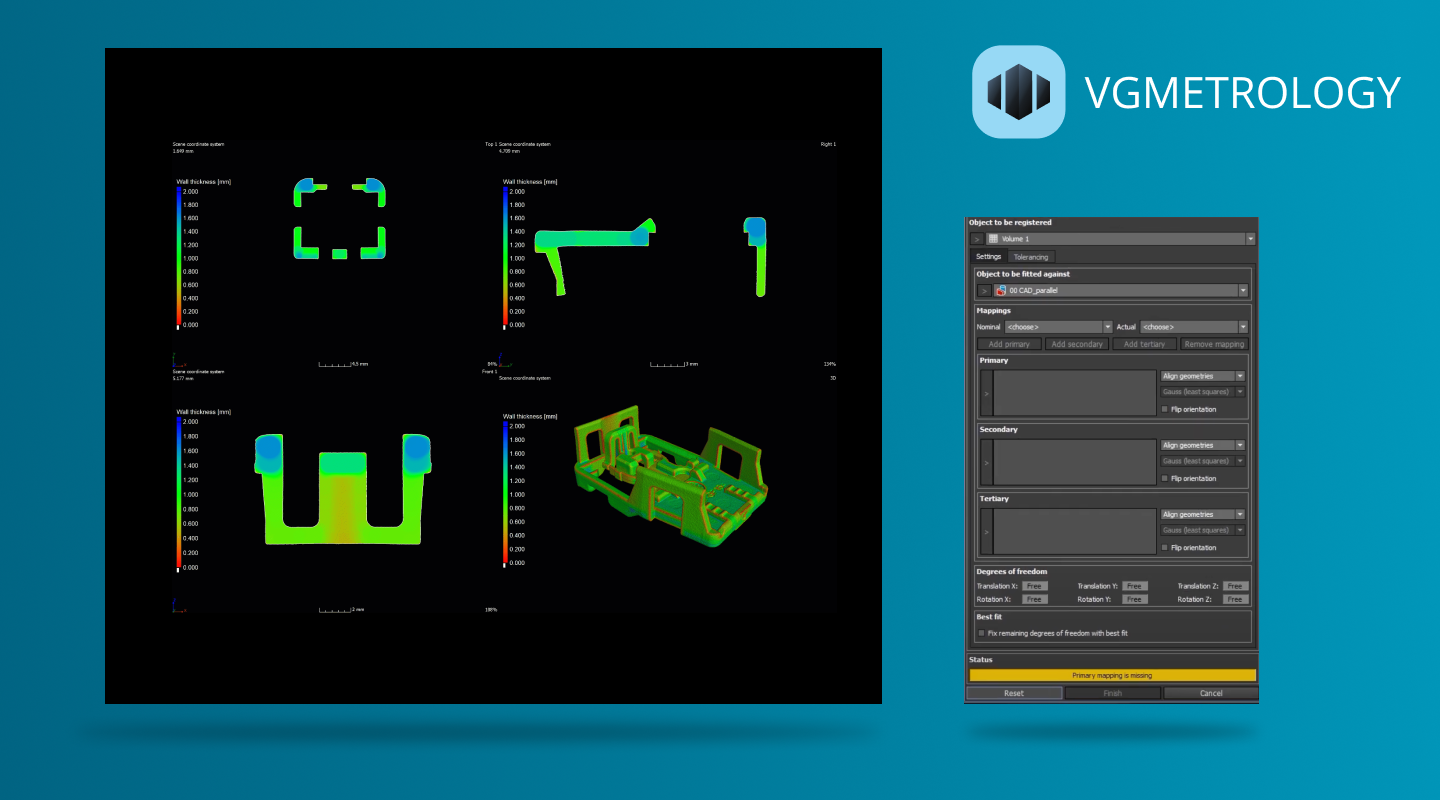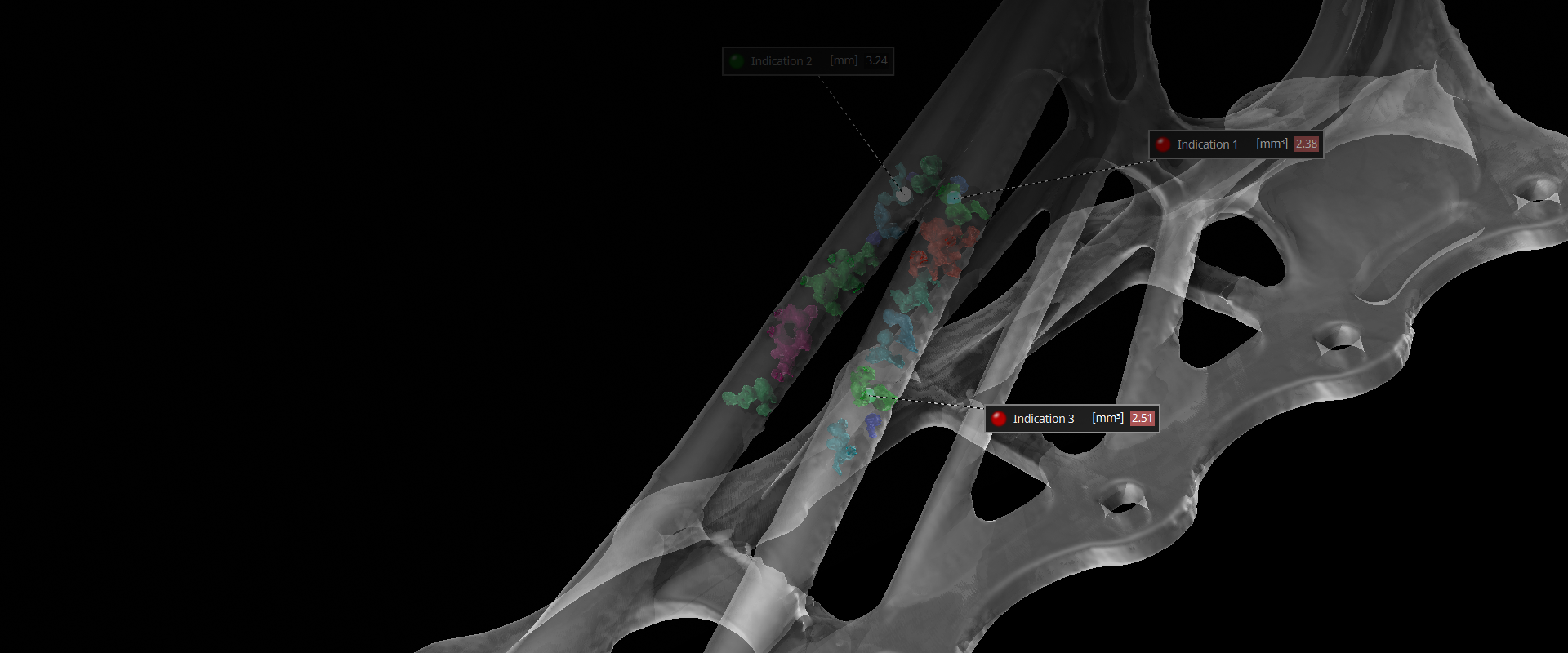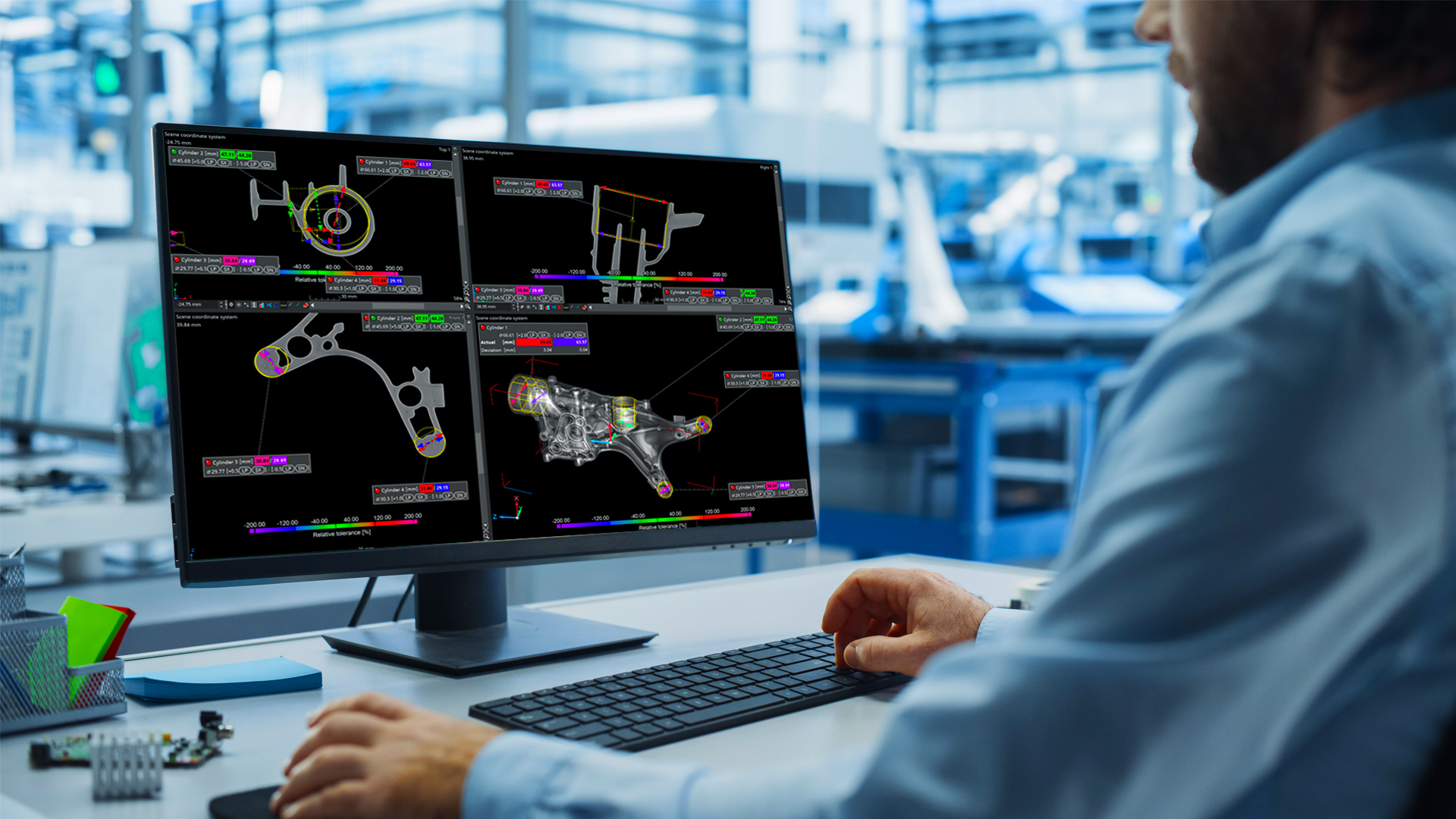“Keyword: .mvgl”
VGMETROLOGY offers versatile data import options, supporting point clouds and meshes from tactile and optical scanners, as well as voxel data from CT scanners.
Explore supported data types
Transform your surface data into captivating 3D and 2D visualisations with VGMETROLOGY. Impress and influence peers, decision-makers, and the public with stunning animations—your only limit is your RAM.
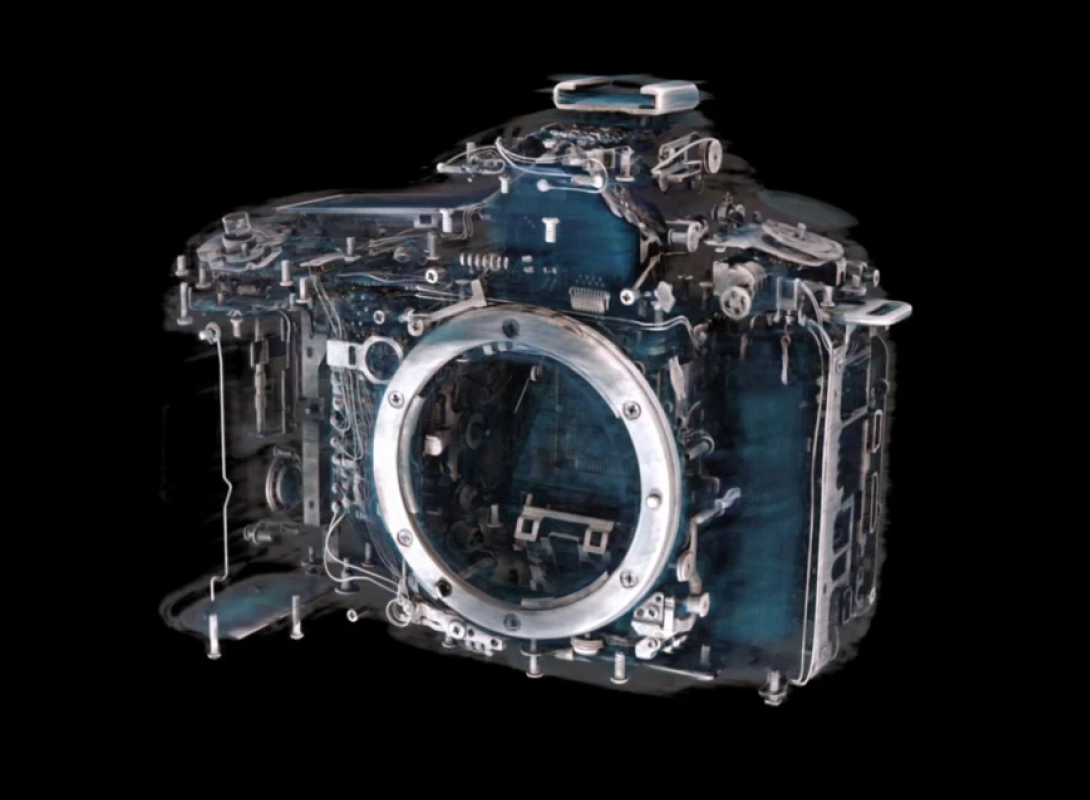
All CT-based metrology relies on accurate surface determination in the voxel model, which reduces measurement uncertainty. Our surface determination minimises measurement uncertainty by being subvoxel-accurate and locally adaptive, enabling the measurement of details smaller than a voxel. It processes grey values based on surrounding voxels for greater accuracy and includes an interval-based mode for high-accuracy, adaptive surface determination in automated environments with variable grey values.
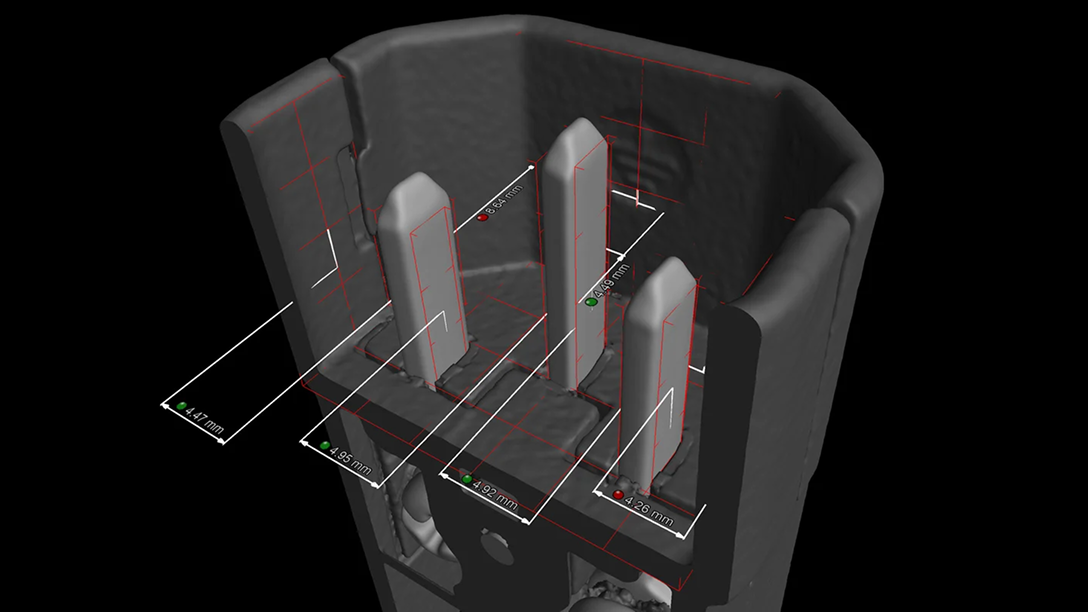
VGMETROLOGY offers robust tools to enhance your inspection processes with:
- Dimensional measurement tools: Conduct precise 2D and 3D measurements.
- GD&T support: Use all 17 GD&T callouts, providing detailed analyses and intuitive colour overlays.
- Adaptive Measurement Template: Use for distorted parts, saving time and eliminating manual rework.
- Nominal/actual comparisons: Produce colour-coded visualisations to identify deviations between manufactured parts and reference data quickly.
- Wall thickness analysis: Evaluate part thickness using tailored methods for different geometries, pinpointing areas with insufficient or excessive thickness.
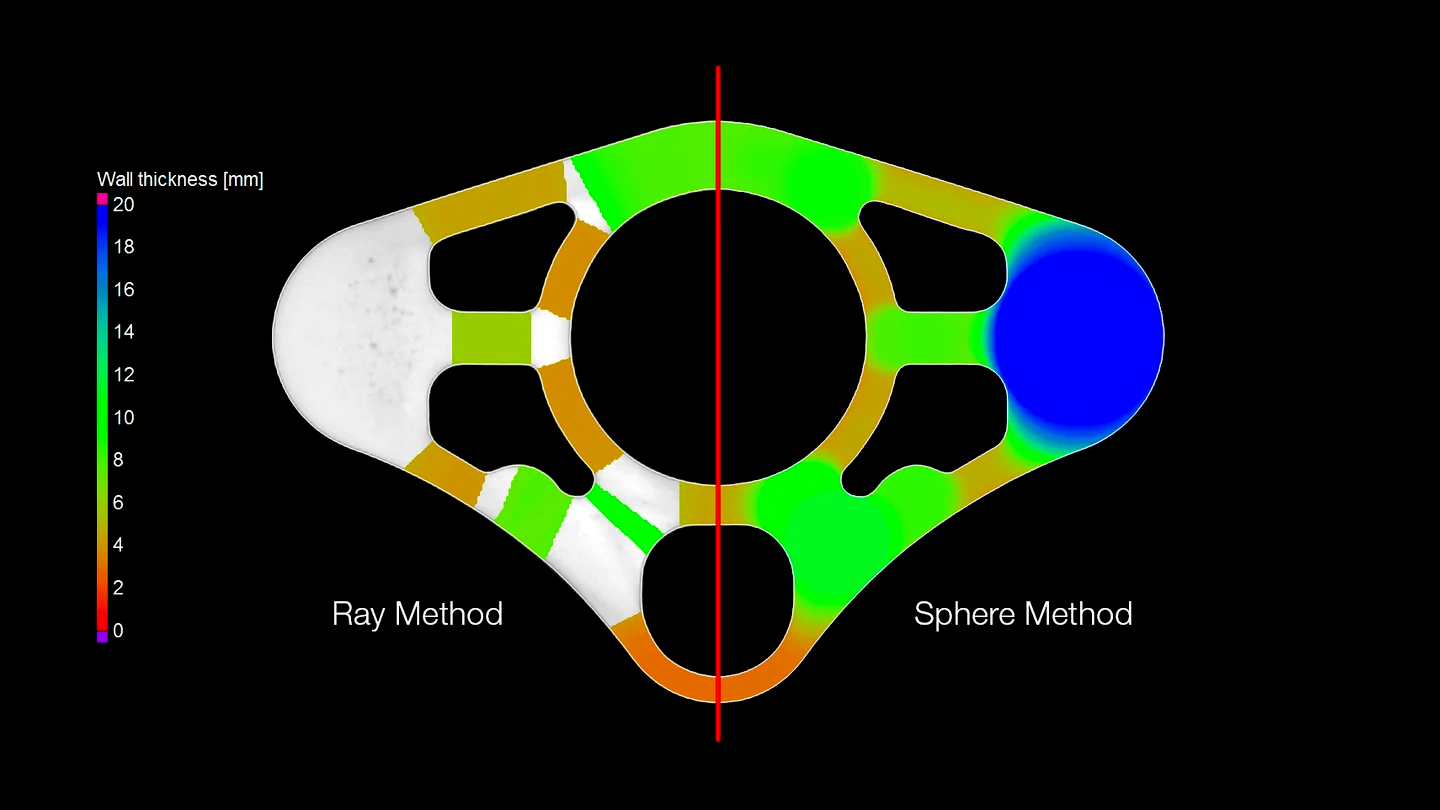
Alignment is crucial for precise measurement results, facilitating the comparison of nominal and measured dimensions and the analysis of assemblies. VGMETROLOGY features versatile alignment options:
- Point-based alignment: Utilize RPS and 3-2-1 methods for aligning data sets to reference points.
- Surface-based alignment: Perform best-fit alignments with constraints or partial areas, focusing on characteristic features.
- Geometry-based alignment: Sequentially align geometry pairs to imitate physical alignments, decreasing degrees of freedom and fixing remaining degrees with a best fit.
- Tolerance alignment results: Assess the quality of alignment outcomes.
- Custom coordinate systems: Implement custom and local coordinate and datum systems for automated measurement updates during alignment changes.
- Non-rigid alignment: Apply as part of the Manufacturing Geometry Correction Module for flexible adjustments.
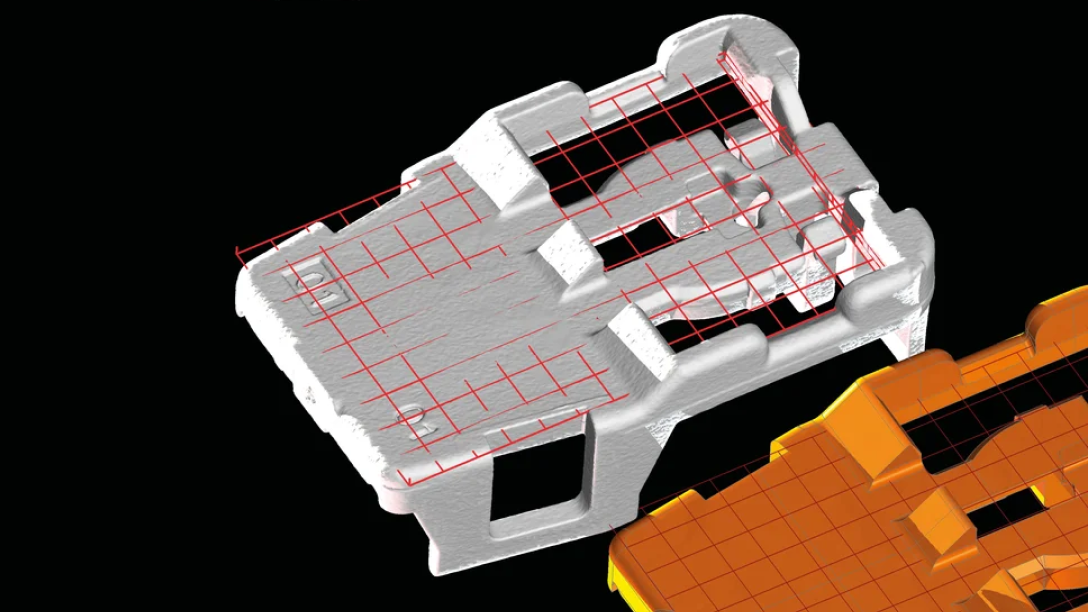
Extracting geometry elements from scans is the basis for evaluating dimensions and tolerances. VGMETROLOGY enables you to:
- Extract geometry elements from scans.
- Automatically recognise the type of geometry element using "Smart Expand."
- Control geometry element fitting by border distance, density, angular deviation, fit method (like Gauss or Chebycheff), and constraining to a position or axes.
- Use algorithms verified by PTB and NIST*.
* PTB- and NIST-verified: This software contains the Volume Graphics Metrology Kernel VGMK 2023.1.0, which passed the PTB test for “Evaluation software based on minimum-zone method for coordinate measuring machines” and the PTB test for “Evaluation software based on least-squares method for coordinate measuring machines” , and which was verified by the NIST “Algorithm Testing and Evaluation Program for Coordinate Measuring Systems”. The test results were obtained under Windows (64 bit).
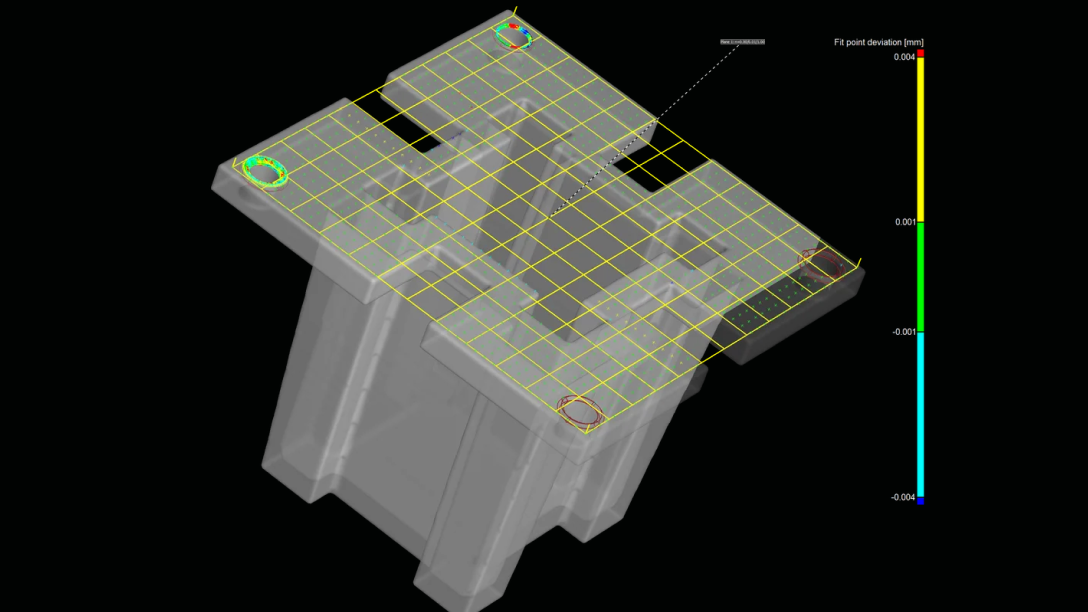
VG software delivers immediate, actionable results, including insightful graphics and detailed reports. Export images, histograms, and data tables in standard formats, create customisable inspection reports, and interface with third-party quality management or statistical process control software like Q-DAS or Metrology Reporting. These reporting features are an excellent way to share the extensive information VGMETROLOGY provides about your scanned parts.

With VGMETROLOGY, work smarter, not harder:
- Streamline inspection and measurement processes through advanced automation and versatile functionality.
- Automate multi-part inspections using macros and batch processing and facilitate the automatic generation and sharing of measurement templates from CAD files. The "Smart Expand" feature simplifies the identification of canonical geometries with a single click.
- Define GD&T analyses on CAD or scans and seamlessly transfer measurement plans between different representations. VGMETROLOGY supports efficient patterning of features and measurement plans, including mirroring and creating helical structures for complex shapes like threads and gears.
- Record macros to automate repetitive tasks and export them for comprehensive automation in VGinLINE.
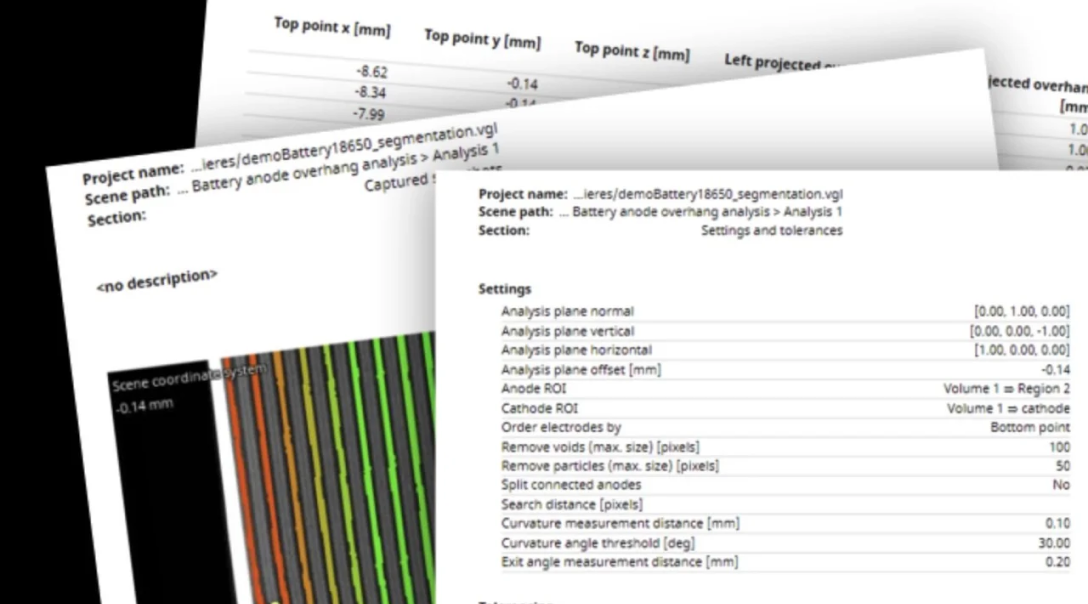

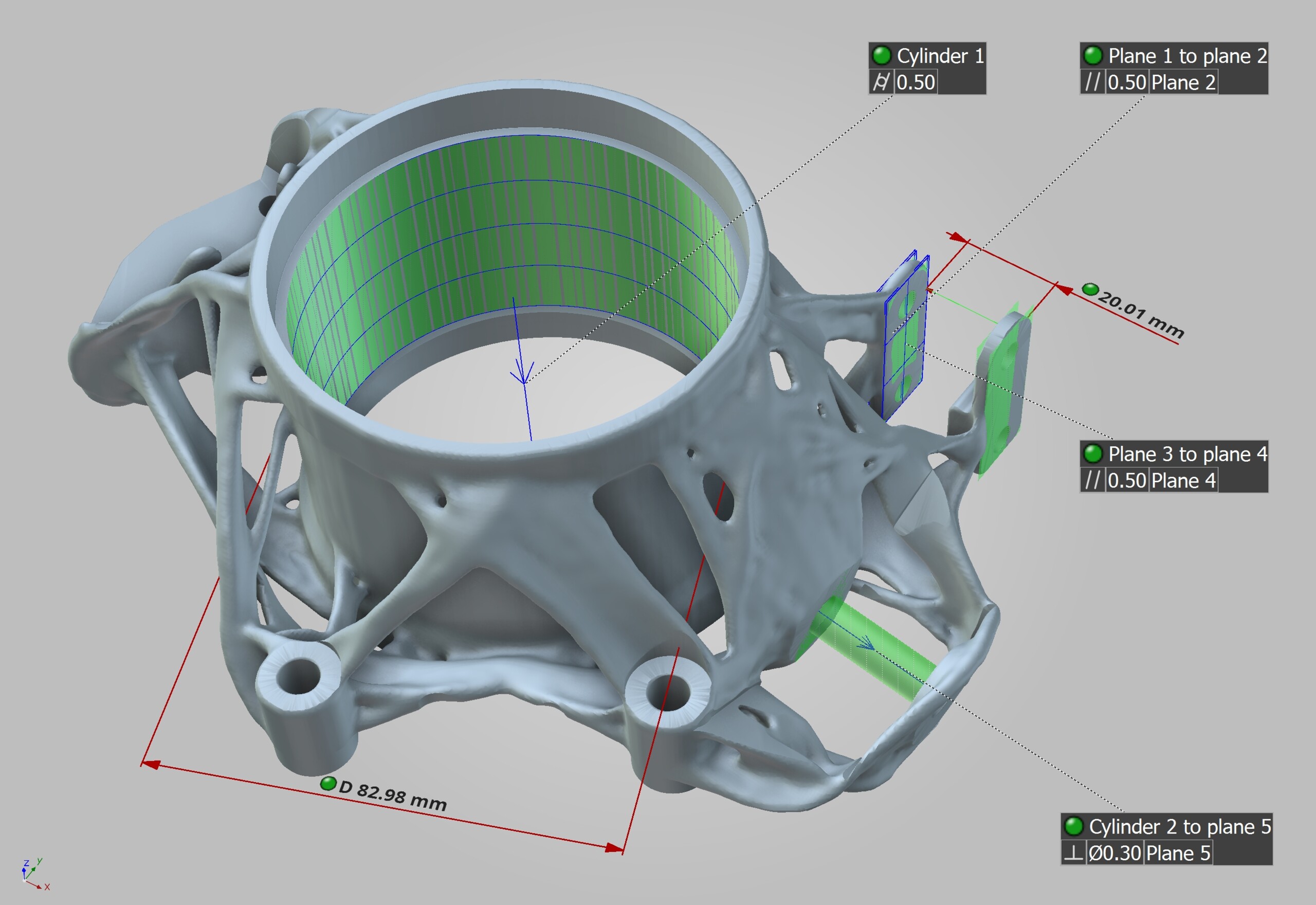
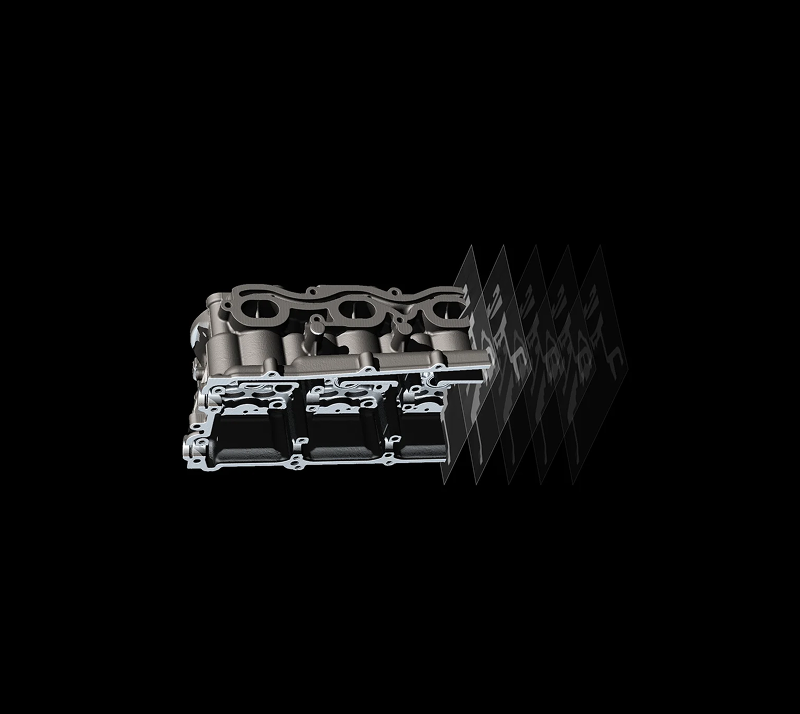

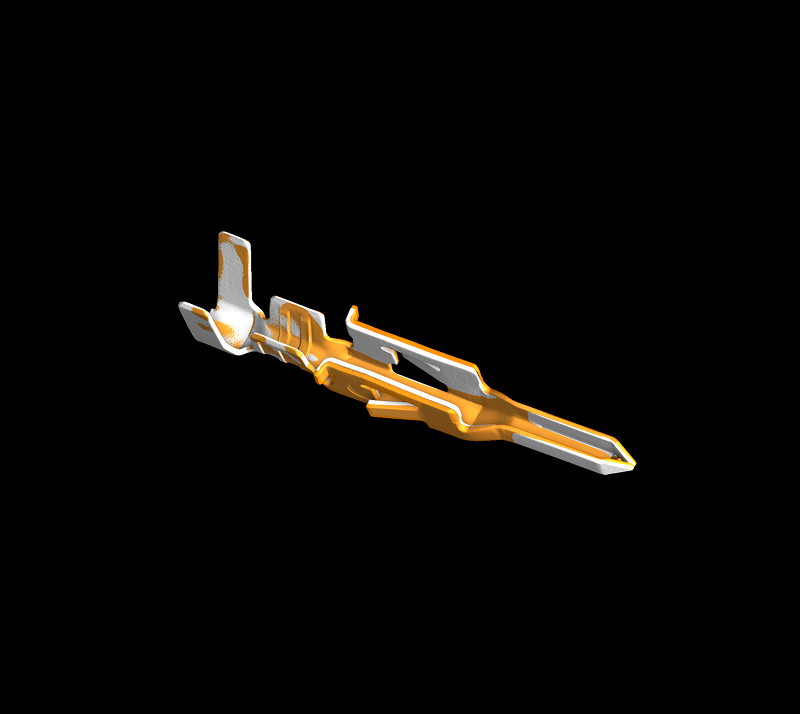



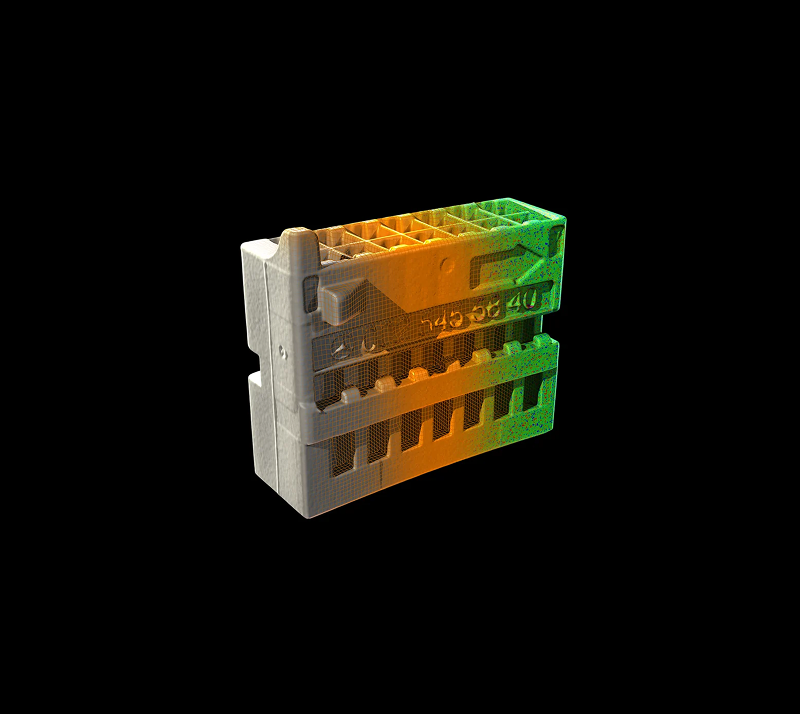
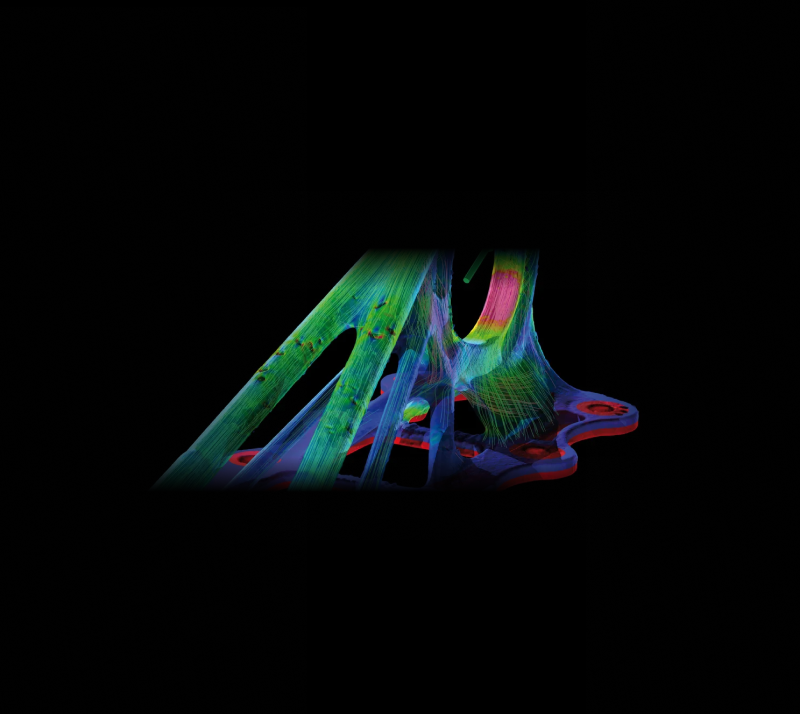
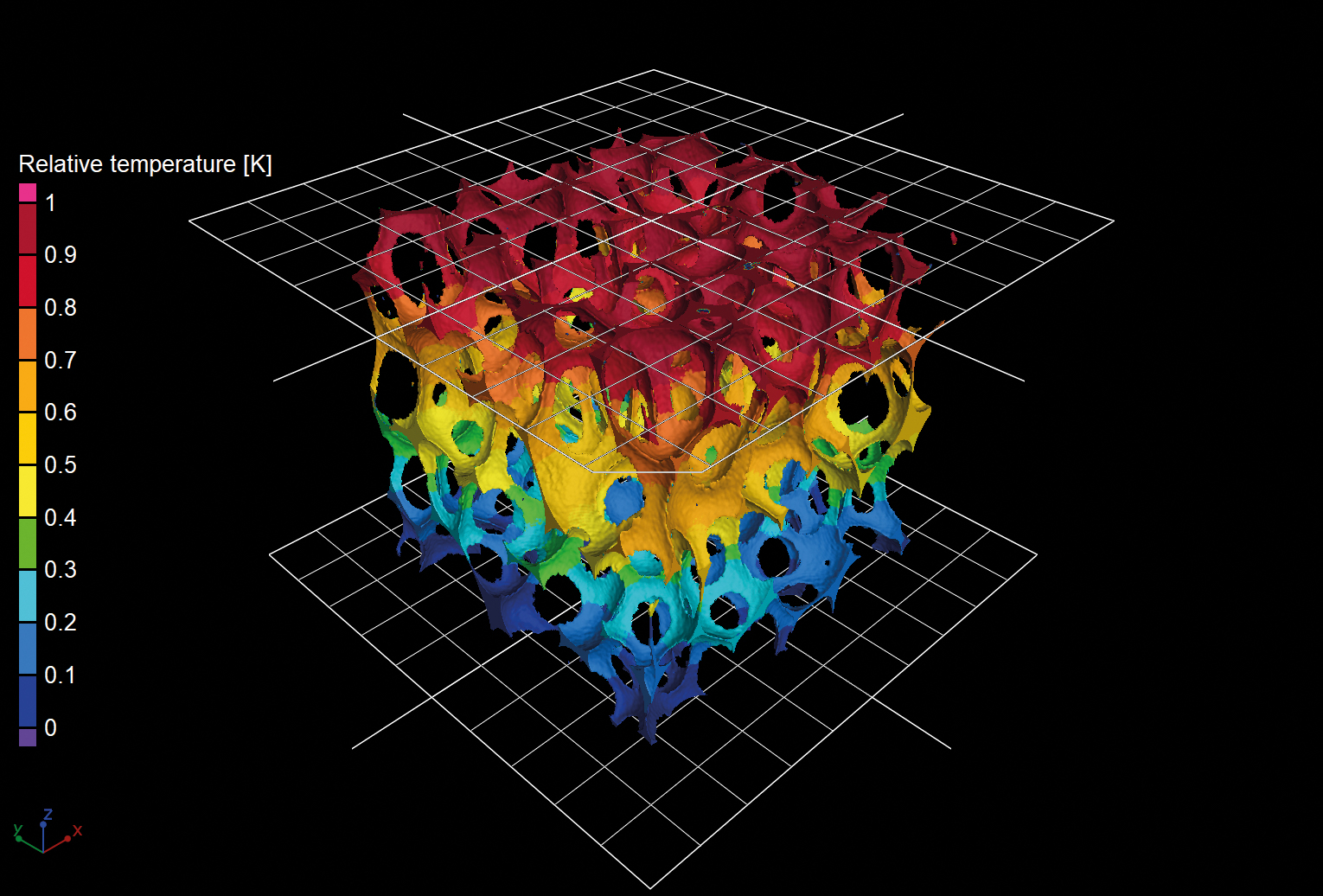
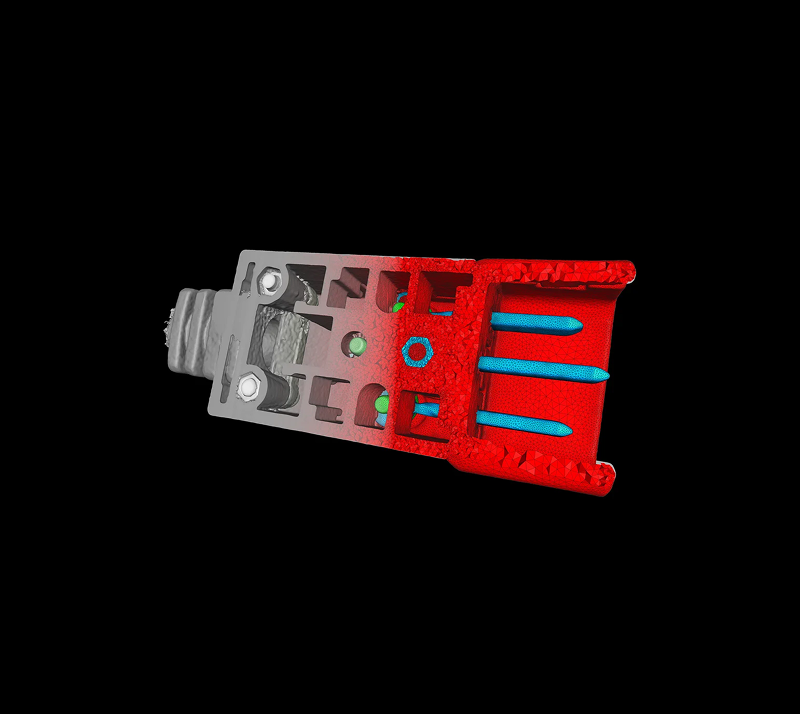
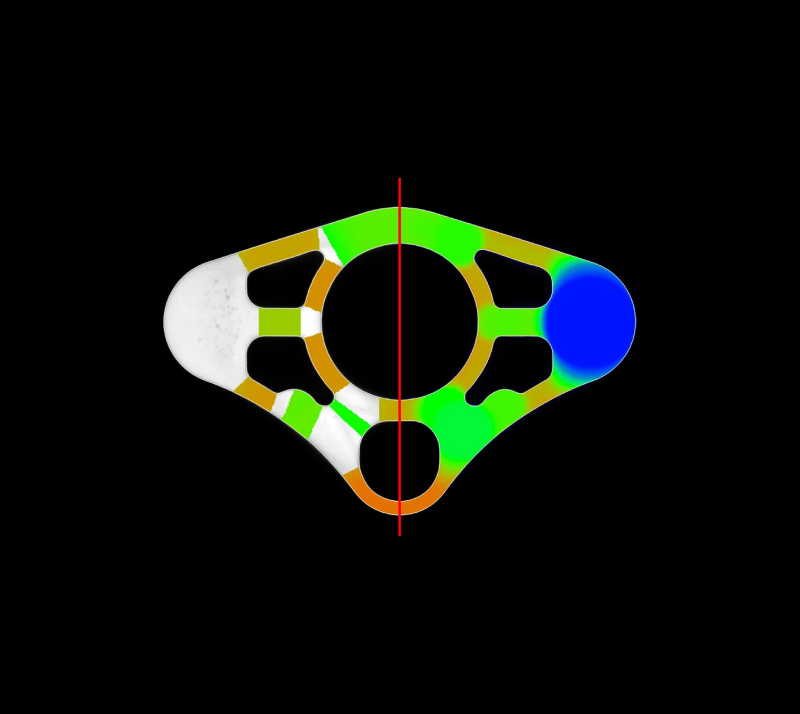
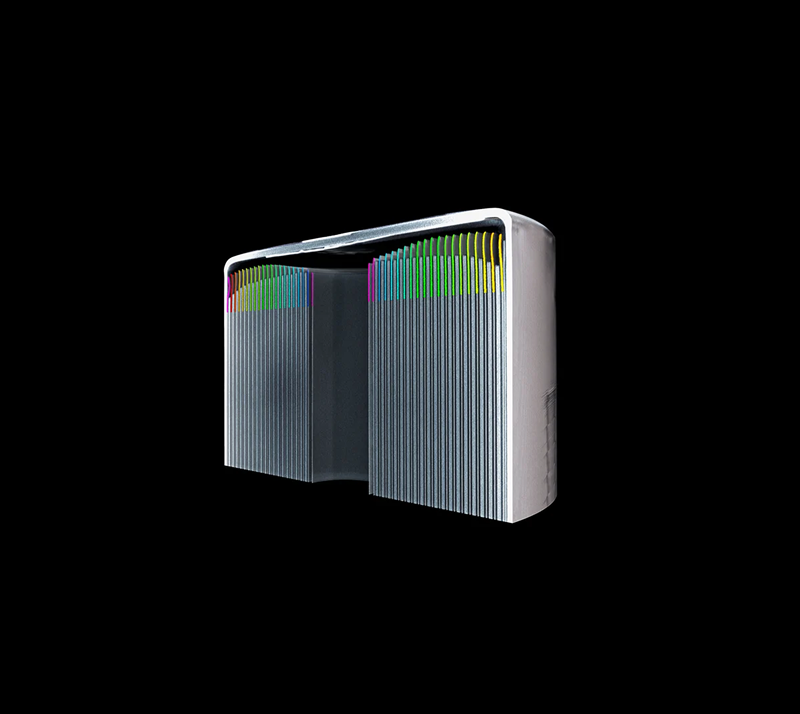


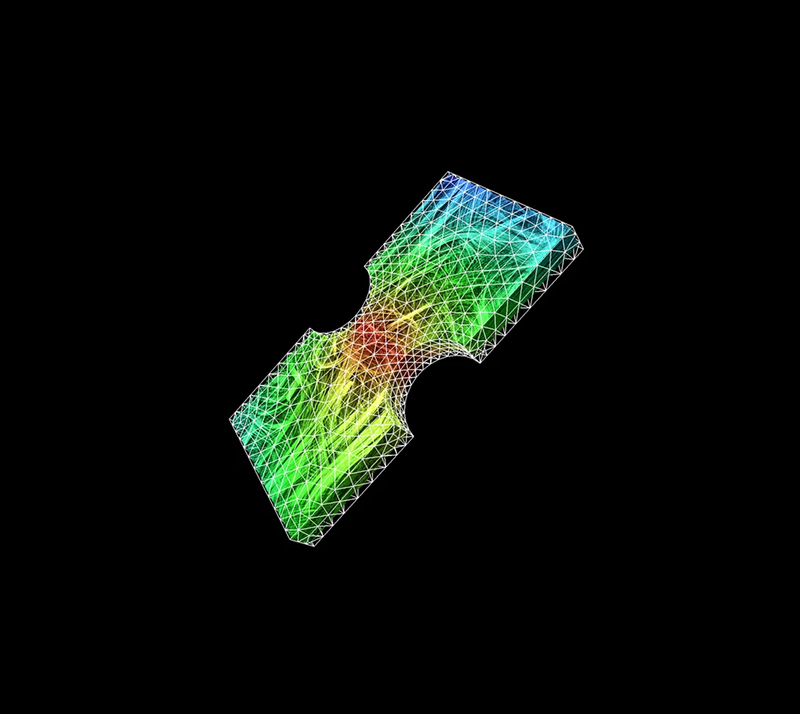
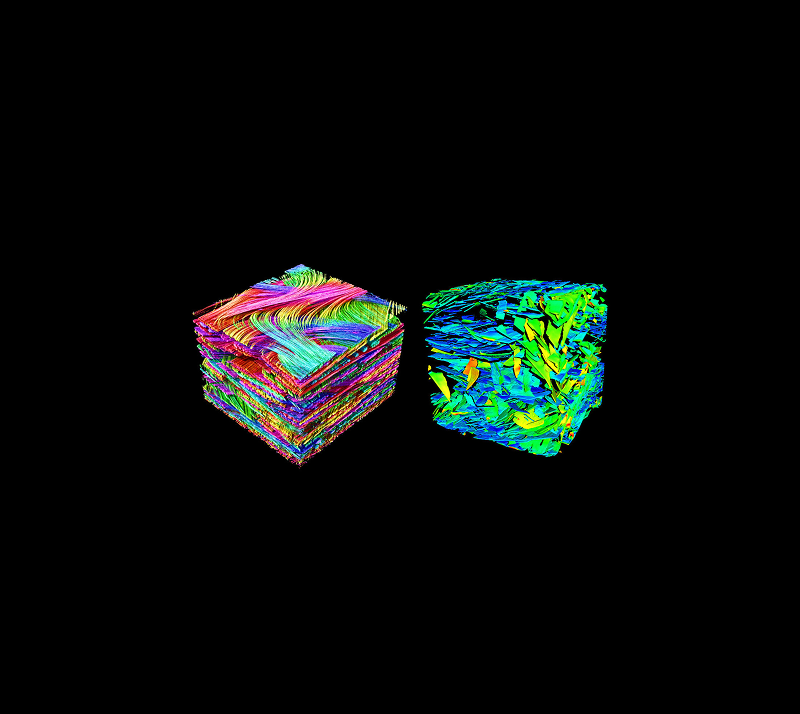

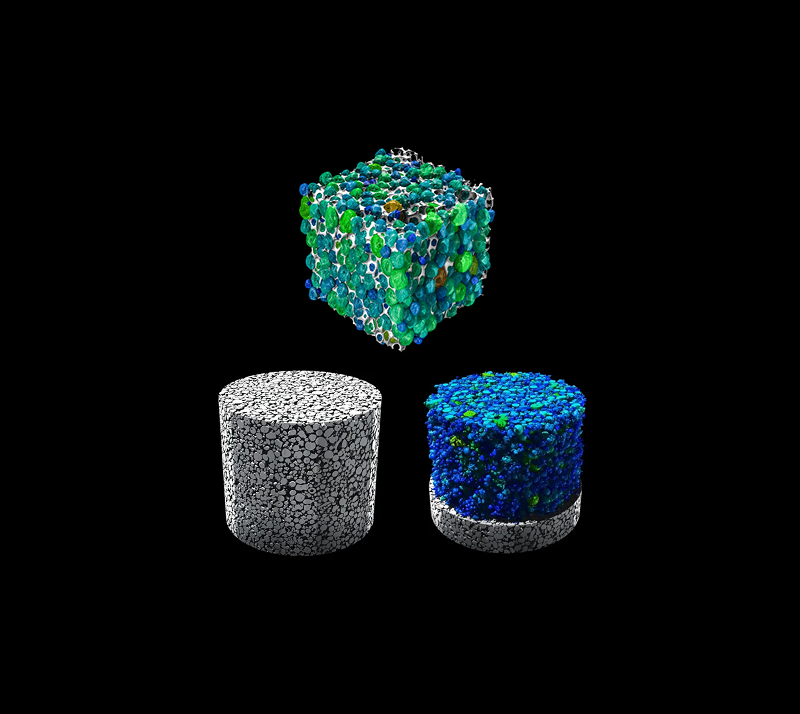
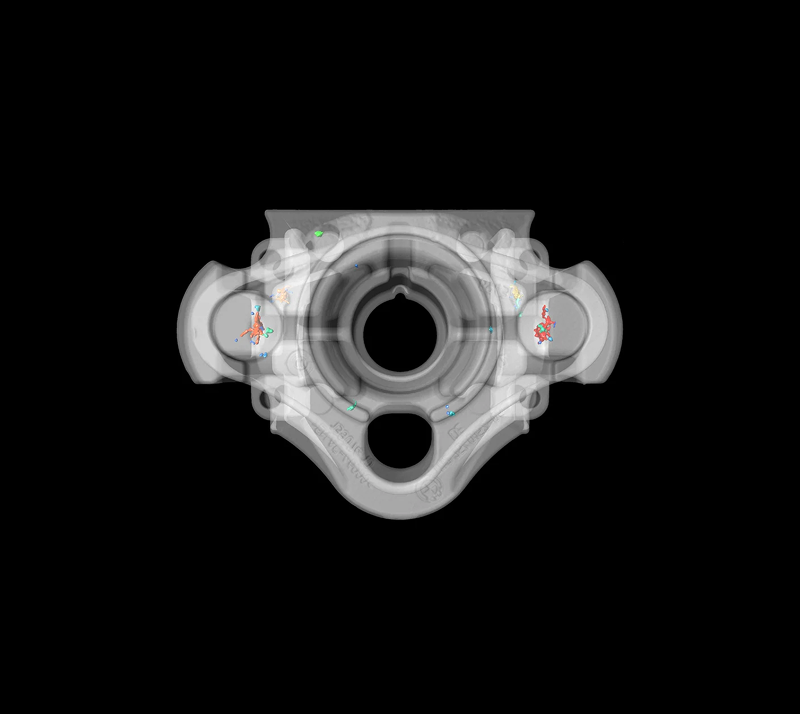



















































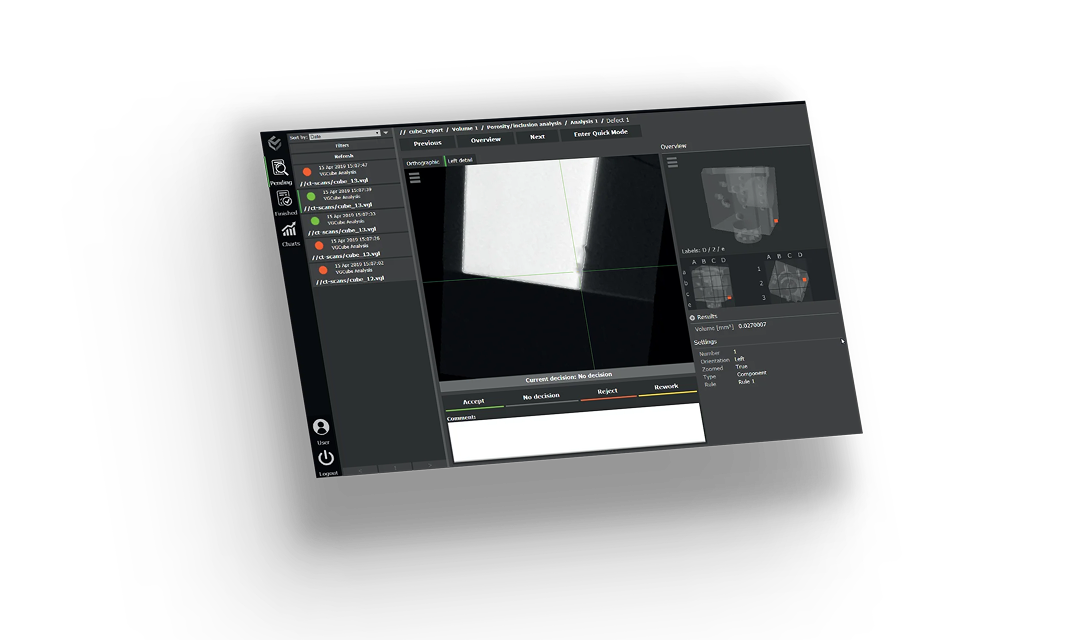
Get your free, 4-week trial license and see why we're the industry’s first and longest-trusted CT analysis software.
Request free trial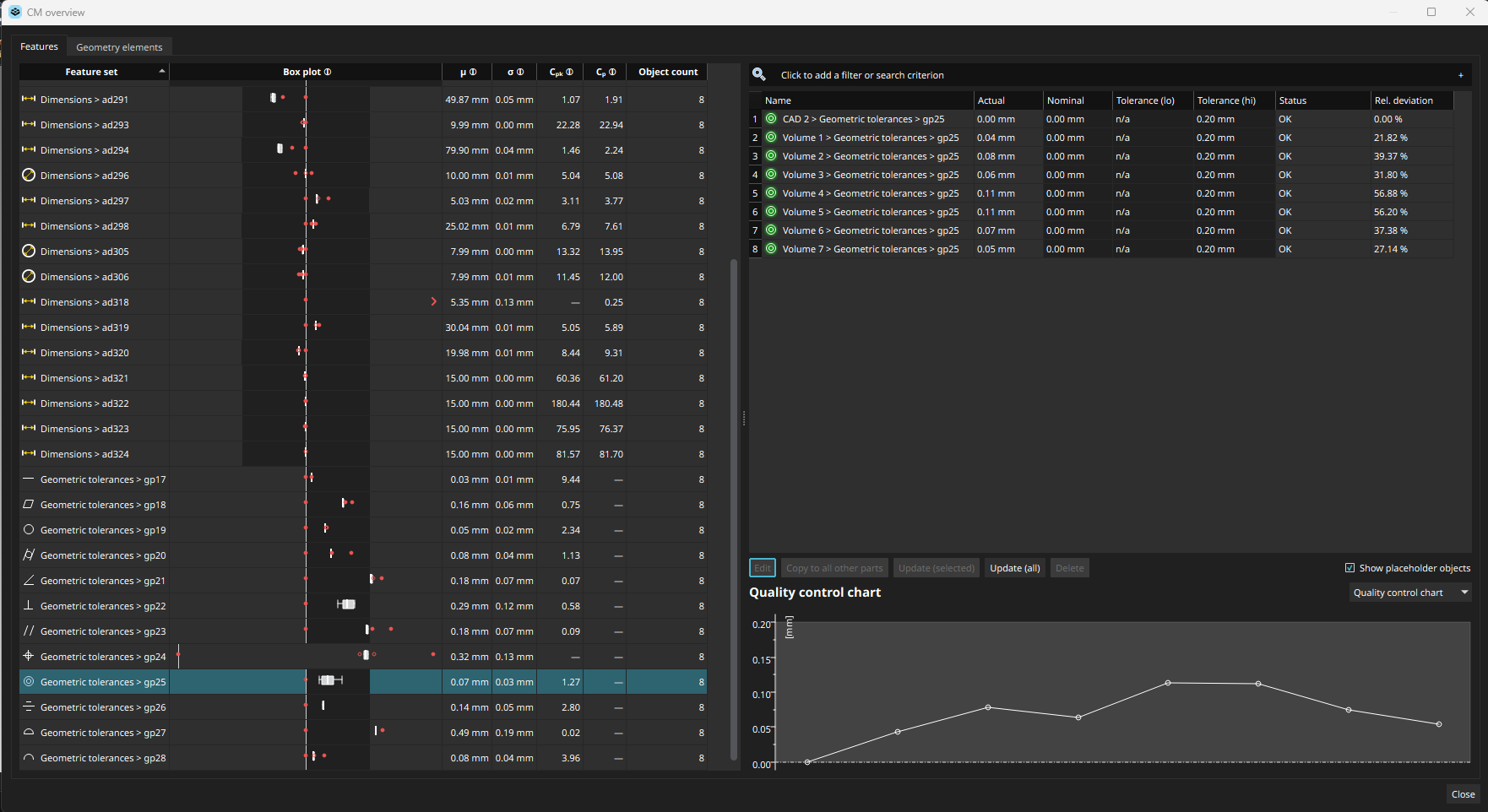
The multipart coordinate measurement feature simplifies the handling of complex projects by allowing users to view, analyze, and edit measurement plans for multiple parts in one central location.
The enhancement includes:
- Essential statistics for features directly in the feature list
- Interactive plotting of different values across all parts for individual features
- Convenient functions for directly editing, removing, and transferring features and geometry elements across all parts, increasing efficiency and ensuring better organization of all project components
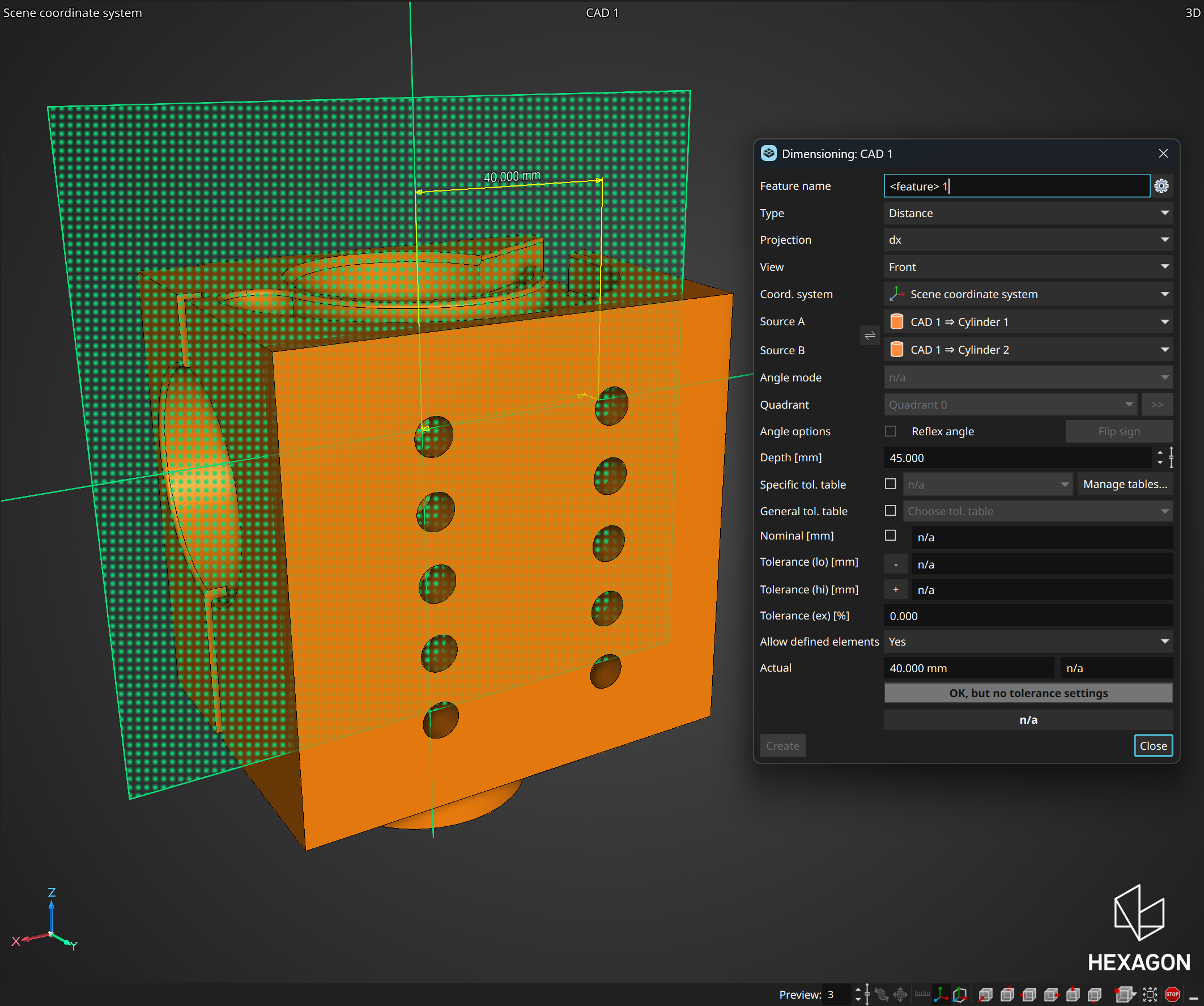
With the “Dimensioning” dialog open, you can now easily create and adjust dimensioning features by dragging and dropping the measurement lines directly in the 3D view, allowing for easy placement in the correct direction and optimal visibility. Additionally, by holding down the “Alt” key, you can create projected dimensions on a preview plane. This enhancement ensures that all lines remain both visible and adjustable, even when located inside the material.
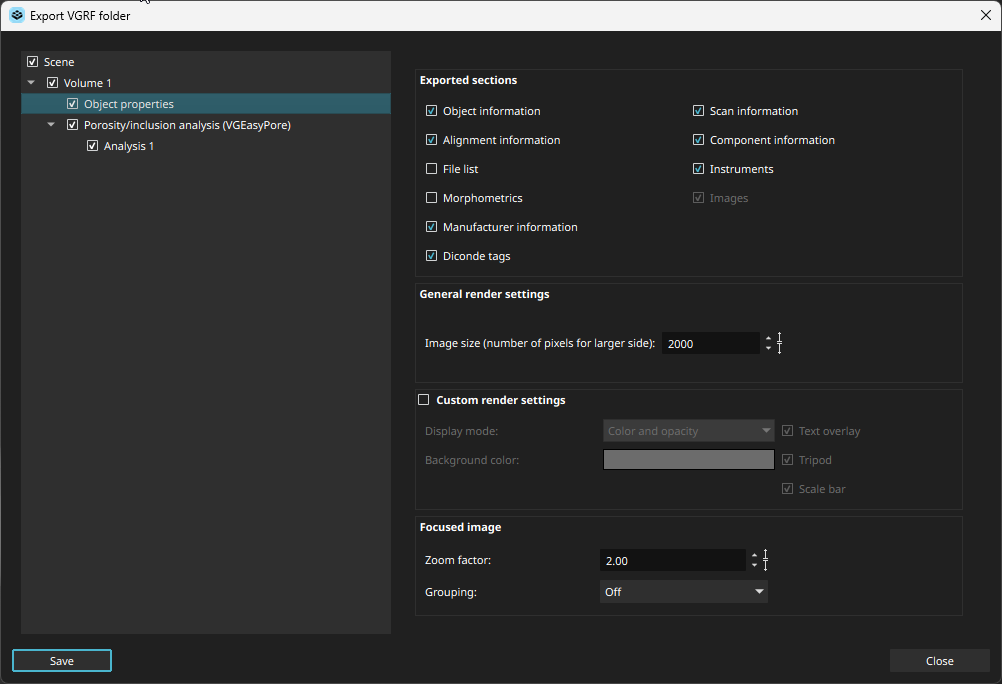
Moving the VGRF export settings to the export dialogs simplifies data export by allowing users to adjust the settings directly when exporting. This enhancement enables the efficient creation of PDF or Excel files with different configurations for repeated exports. Additionally, the outdated "VGRF export" tab has been removed.

We removed the outdated reporting tools to prioritize the modern, more powerful reporting functionality, ensuring a smoother and more efficient experience for creating reports, while still temporarily supporting it in older macros to ease the transition.

This feature enables users to incorporate mesh-related metainformation in inspection reports, just as it is already possible for volume metainformation. This enhancement makes reports more customizable and improves traceability, providing greater clarity and more comprehensive documentation.
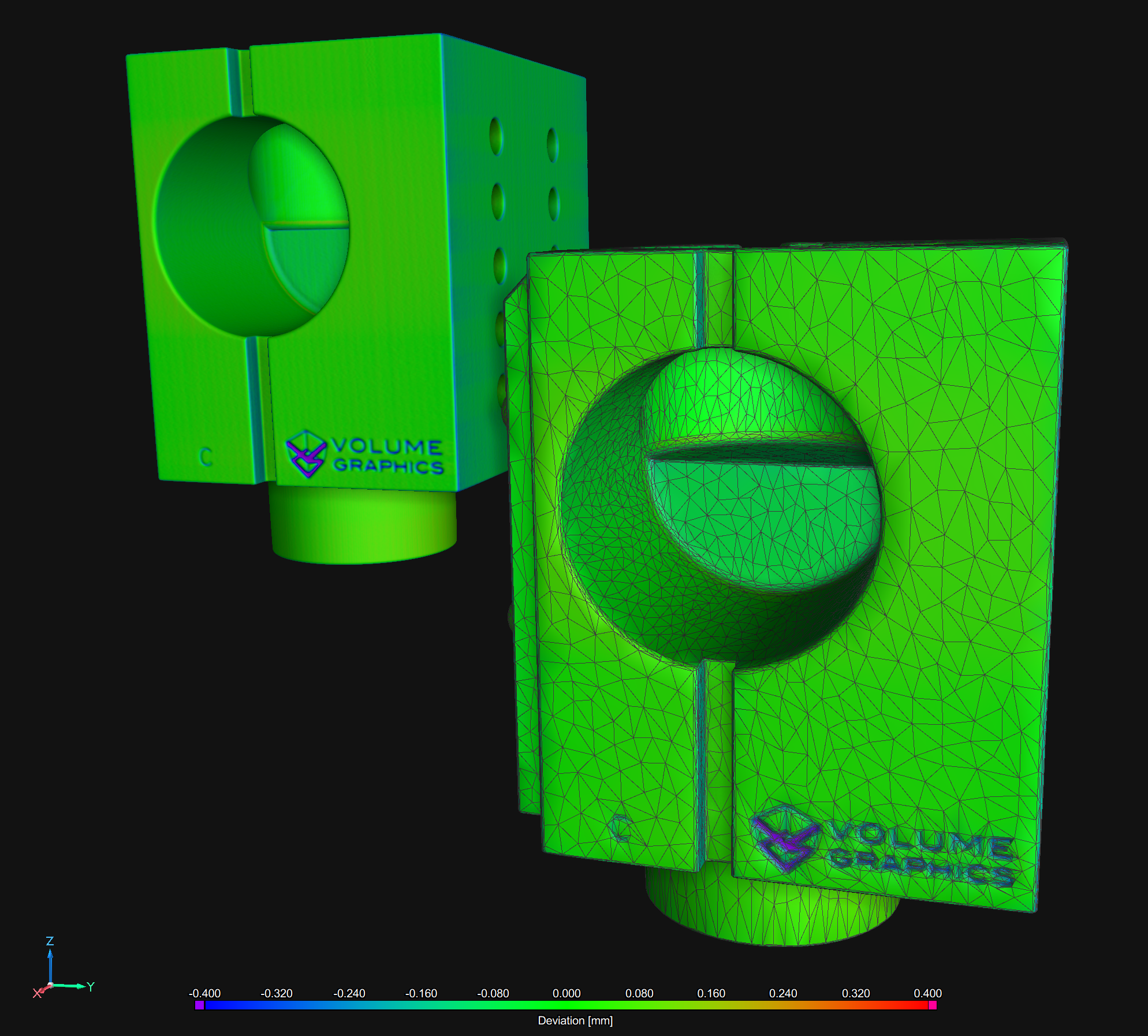
The enhanced mesh import and export feature now supports GLB/GLTF, AMF, and 3MF file formats, making it easier to exchange 3D surface data with other applications. This allows you, for example, to directly import and use mesh data created for additive manufacturing and stored in AMF or 3MF formats as nominal reference data without the need to convert it to an intermediate format or export colored meshes created from analysis results or extracted from volume objects in GLB format, which can be easily exchanged with other applications such as PowerPoint.

The surface/contour smoothing feature for volume-to-CAD conversion simplifies reverse engineering by allowing users to directly smooth rough volume surfaces or ROI contours in the “Object conversion” dialog. It eliminates complex workarounds and preserves project structures, with the added benefit of being macro-recordable for efficient processing.
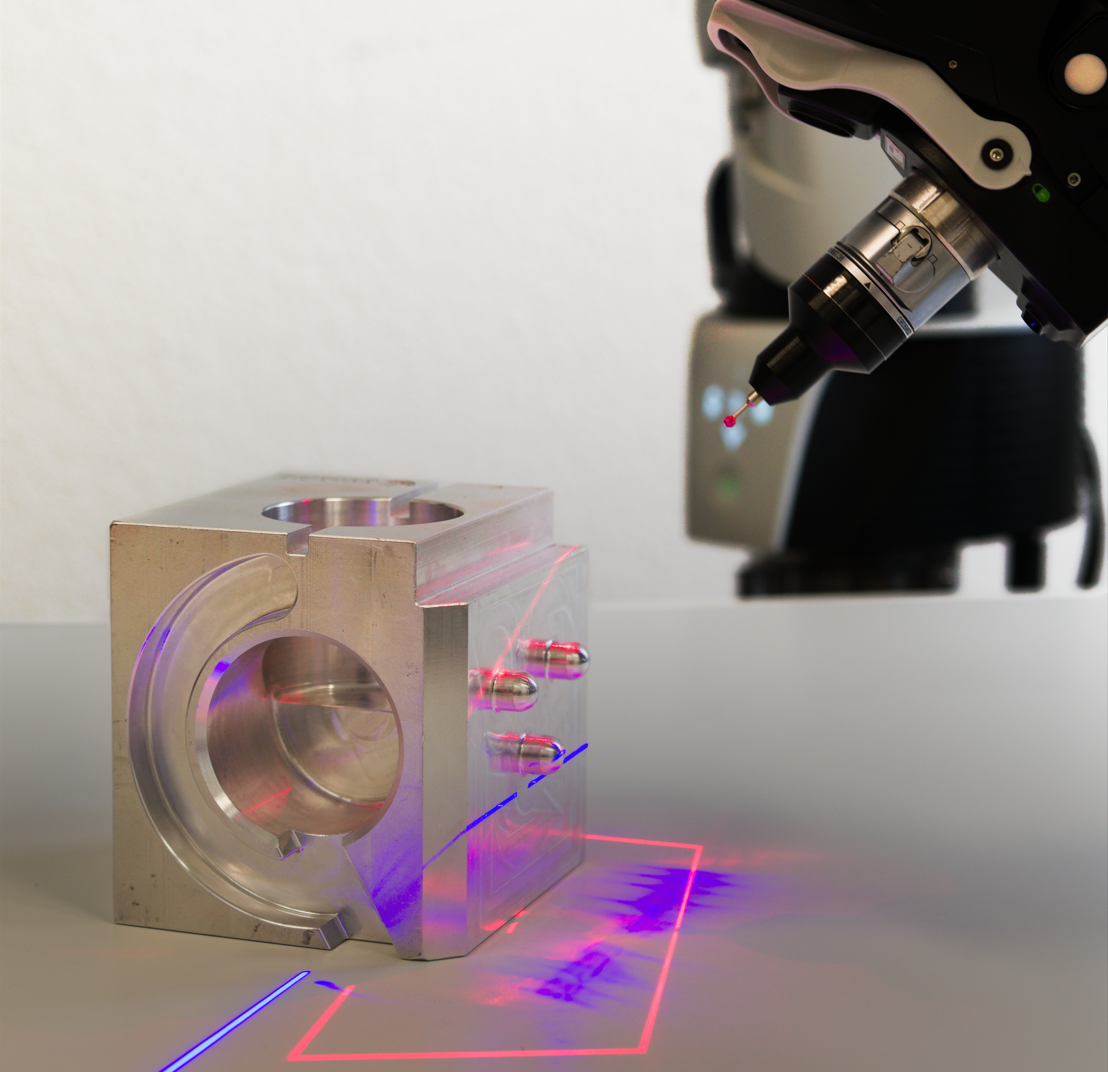
This new integration with Hexagon hardware is a pivotal advancement in unifying diverse surface data acquisition technologies within a single software application. Traditionally, different technologies required separate software applications, but with this integration, VGSTUDIO MAX and VGMETROLOGY now directly support the Absolute Arm and AS1 scanner.
This integration enables tactile measurement of features, point cloud scanning, and surface mesh reconstruction, all within a unified scan object. This scan object supports the full suite of metrology and reverse engineering functions, allowing measurement, evaluation, and automation strategies to be applied consistently, just as with CT data.
This development marks a significant step towards a comprehensive non-destructive evaluation (NDE) solution. It not only standardizes measurement approaches across various data sources but also facilitates the combination of different evaluations within a single application. For instance, users can detect internal defects with CT data, assess positional deviation through tactile measurements using the Absolute Arm, evaluate surface deviations with AS1 scan data, and analyze surface roughness with GelSight scans—all seamlessly within one platform.
Reduce uncertainty and operational overhead by eliminating the need to manage multiple software solutions, streamlining your workflow and enhancing analytical precision.
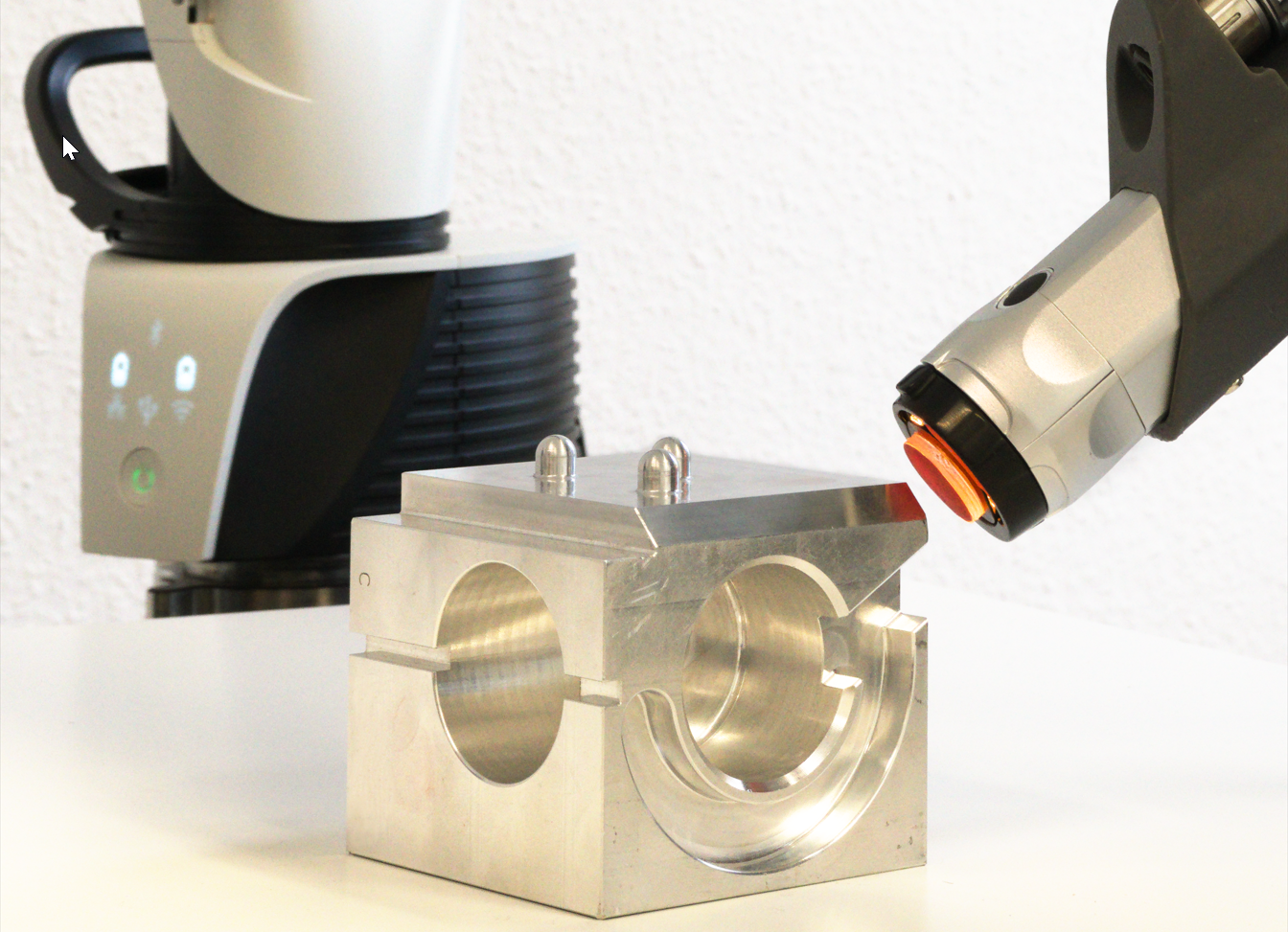
This exciting addition introduces surface roughness analysis, powered by GelSight hardware and GelSight Mobile software, into VG software, expanding the analysis capabilities of VGSTUDIO MAX and VGMETROLOGY. With this hardware integration, you can acquire, import, and visualise GelSight patches and height maps and trigger and visualise surface roughness calculations. When used alongside Hexagon’s Absolute Arm, it enables the visualisation of high-resolution surface information accurately positioned on a 3D model of the entire part. This unique solution allows for the correlation of data obtained through various acquisition methods and inspected in diverse ways, offering a comprehensive approach to surface analysis and enhancing your non-destructive evaluation processes.
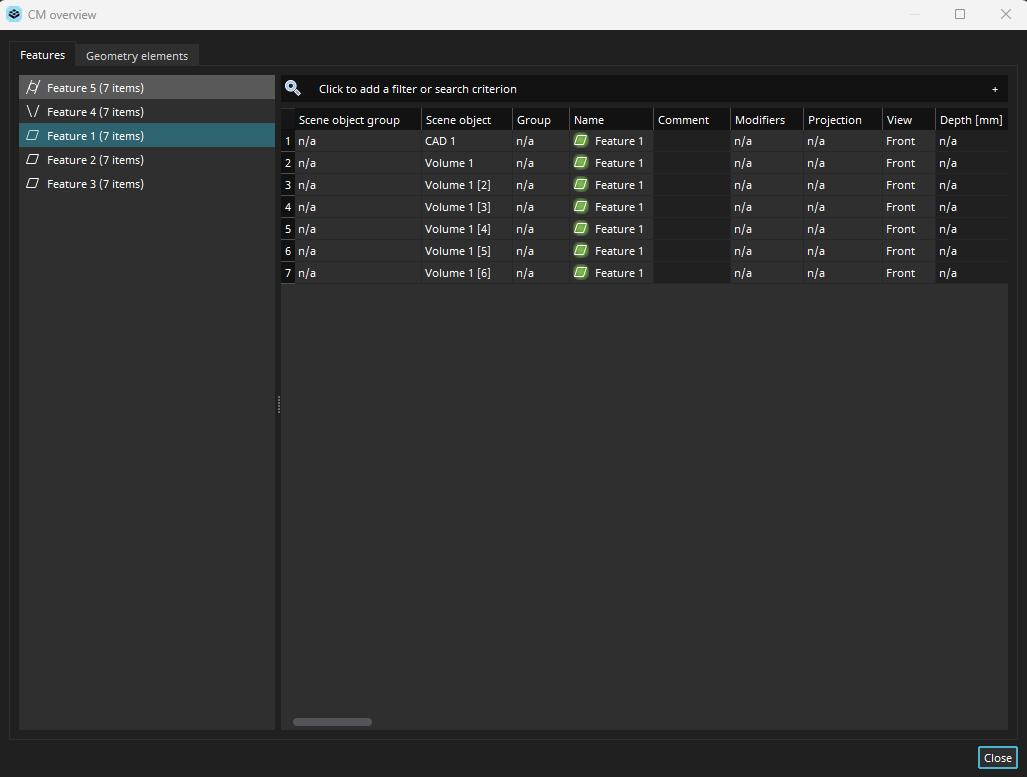
The new coordinate measurement overview dialog empowers users to efficiently analyze measurements and geometric tolerances across multiple scans, transforming the way users manage multipart projects with numerous coordinate measurement (CM) elements.
In this comprehensive overview dialog, objects are intuitively grouped by their name and group, facilitating streamlined navigation and analysis. The table view enables users to assess all geometry elements and features across several scans, providing a holistic view of project data. Additionally, certain parameters of these objects can be edited simultaneously in the table, ensuring consistent updates across all scans.
The new overview dialog provides a new way of working with coordinate measurements done on multiple parts, greatly increasing efficiency in these scenarios.
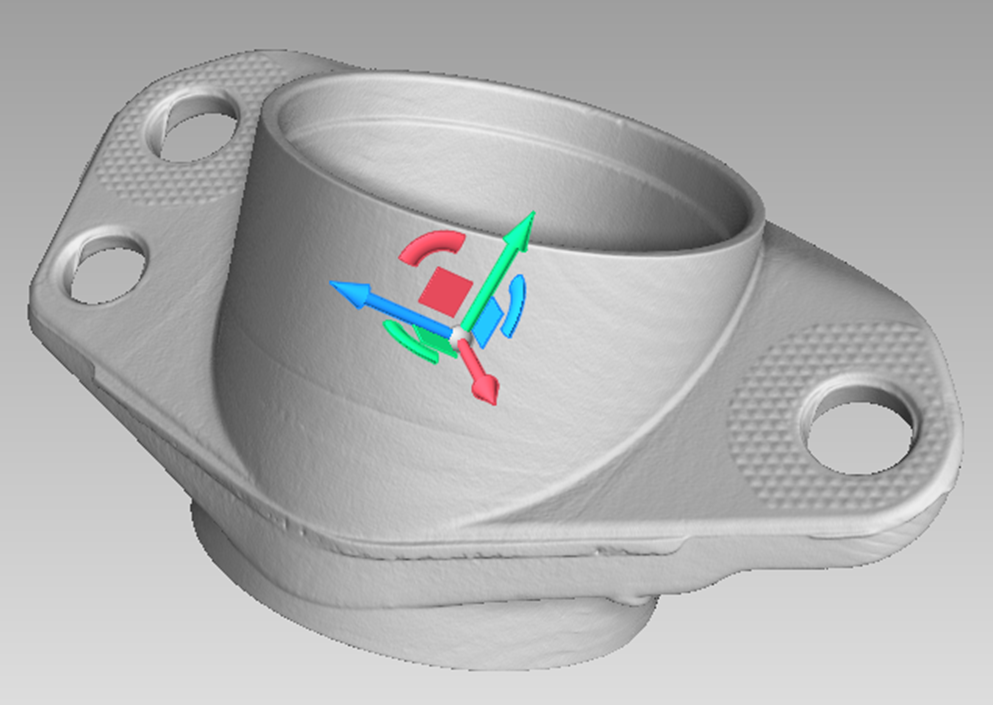
This feature enhances the interactive movement of objects within a plane. The transformation tripod now includes planar handles, allowing users to move objects effortlessly within a plane. These additional handles significantly simplify object transformations, providing a more intuitive and efficient workflow.
This capability is particularly beneficial when working with optically scanned point clouds, where moving resulting patches within a plane is frequently required. With this enhancement, users can achieve precise planar movements with just a single mouse click and move action, streamlining the process and improving overall handling efficiency.

Designed to enhance the accuracy of optical character recognition, this new function addresses misidentification of characters due to data quality or font variations, in which, for example, a "1" might be mistaken for an "I" or a "5" for an "S." By leveraging character substitutions and applying constraints based on the expected text format (e.g., numeric-only entries in specific positions), this feature can automatically correct these misidentifications to a significant extent. This improvement enhances the reliability of text recognition in your analysis.

As we continue to enhance the VG software experience, we will retire legacy reporting with the 2025.3 release this fall. The integrated reporting editor introduced with version 3.4.4 and continuously enhanced since then offers a full-featured solution for creating and adapting report documents, surpassing the capabilities of the legacy reporting.
Starting with version 2025.3, you will no longer be able to create legacy reports. The macros designed for these reports will cease to function in subsequent versions.
We encourage you to transition to the integrated reporting editor to take advantage of its robust features and improved functionality.
We value your feedback and are here to assist with any concerns regarding this change. Please reach out to us if you have any questions or require support during this transition. Together, let's embrace a more efficient and powerful reporting experience with VG software.

This significant enhancement is tailored for complex cases involving high morphing complexity and partial scans.

Microsoft will be ending support for Windows 10 in October 2025. In alignment with this change, we will also conclude official support for VG applications running on Windows 10 starting with version 2025.3.
We encourage affected users to upgrade their operating system to continue benefiting from the full capabilities of VGSTUDIO, VGSTUDIO MAX, VGMETROLOGY, VGinLINE, and other VG software products.
This is an important step towards ensuring our VG software suite operates optimally on modern platforms, providing you with enhanced performance, security, and compatibility.
For assistance with upgrading or any questions, please contact our support team.

Did you know that you can save your customized report layout as default layout and reuse it for other reports? If not, follow this tutorial and learn how it works.
Watch now

- Applying a macro to multiple volumes
- Learn how to save valuable time by running a macro on multiple volume objects.
- Assigning shortcuts to macros
- Learn how to use shortcuts for macros to execute complex workflows at the touch of a button!
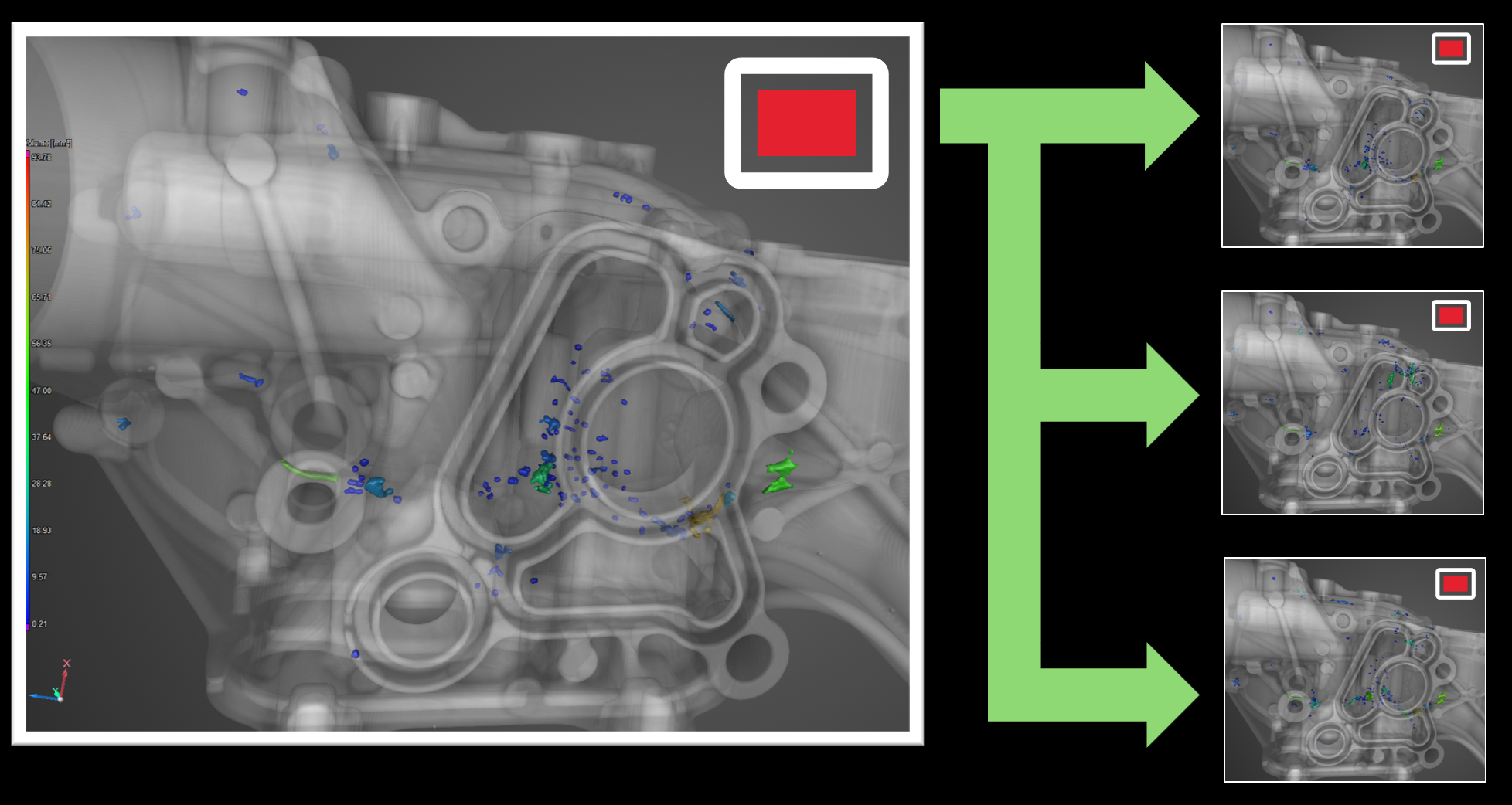
Define and apply visualization and workspace settings as "Views" for individual objects, enhancing project navigation and report generation. Easily transfer these views between objects and incorporate them into evaluation templates for streamlined automation.
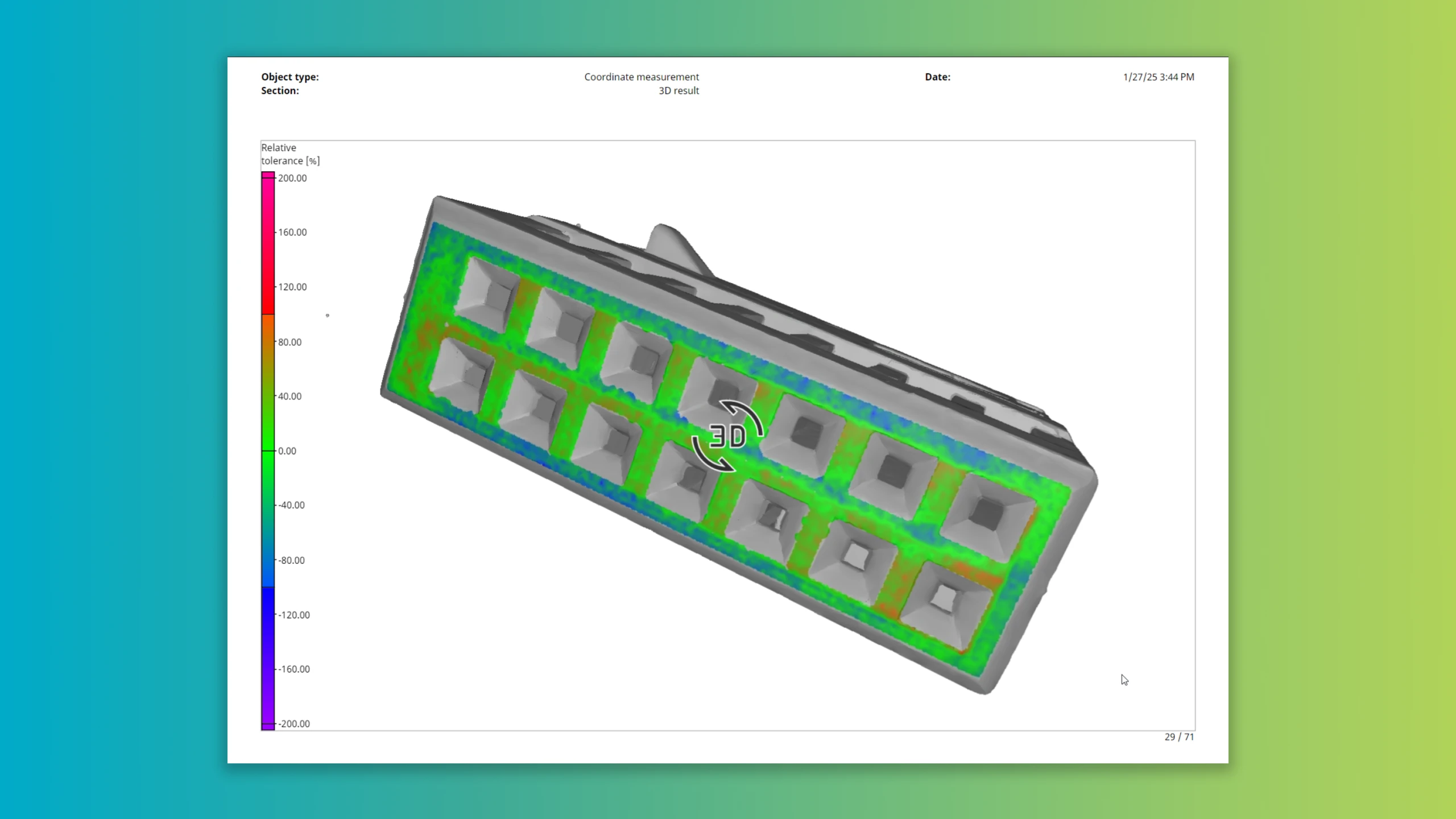
Enhance your reports with interactive 3D color overlays for geometric tolerances, facilitating a better understanding of numerical results.
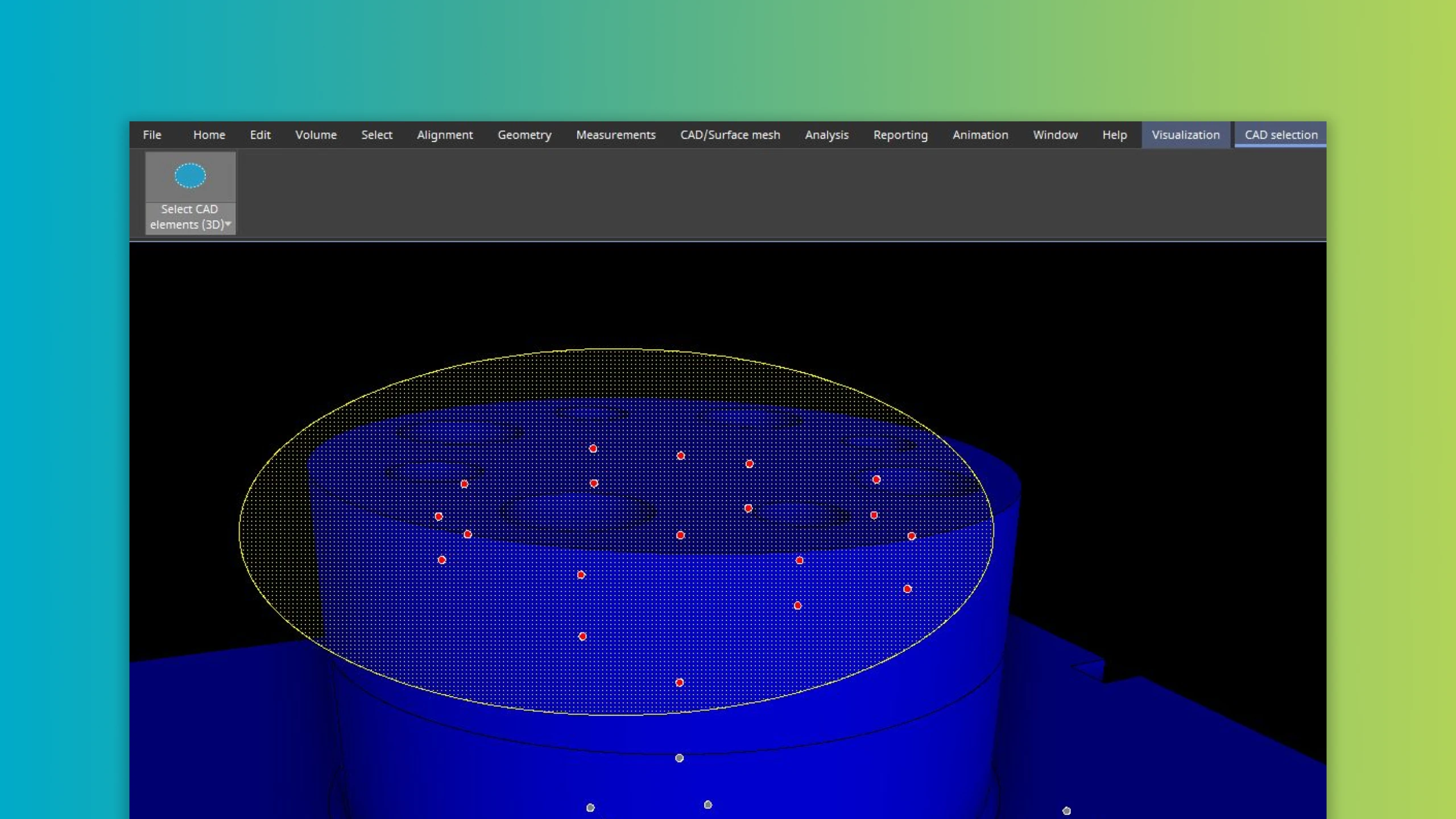
Select multiple CAD faces effortlessly using intuitive tools like rectangle, ellipse, and lasso in the 3D view. This feature simplifies working with complex components, aligning with object and fit point selections.
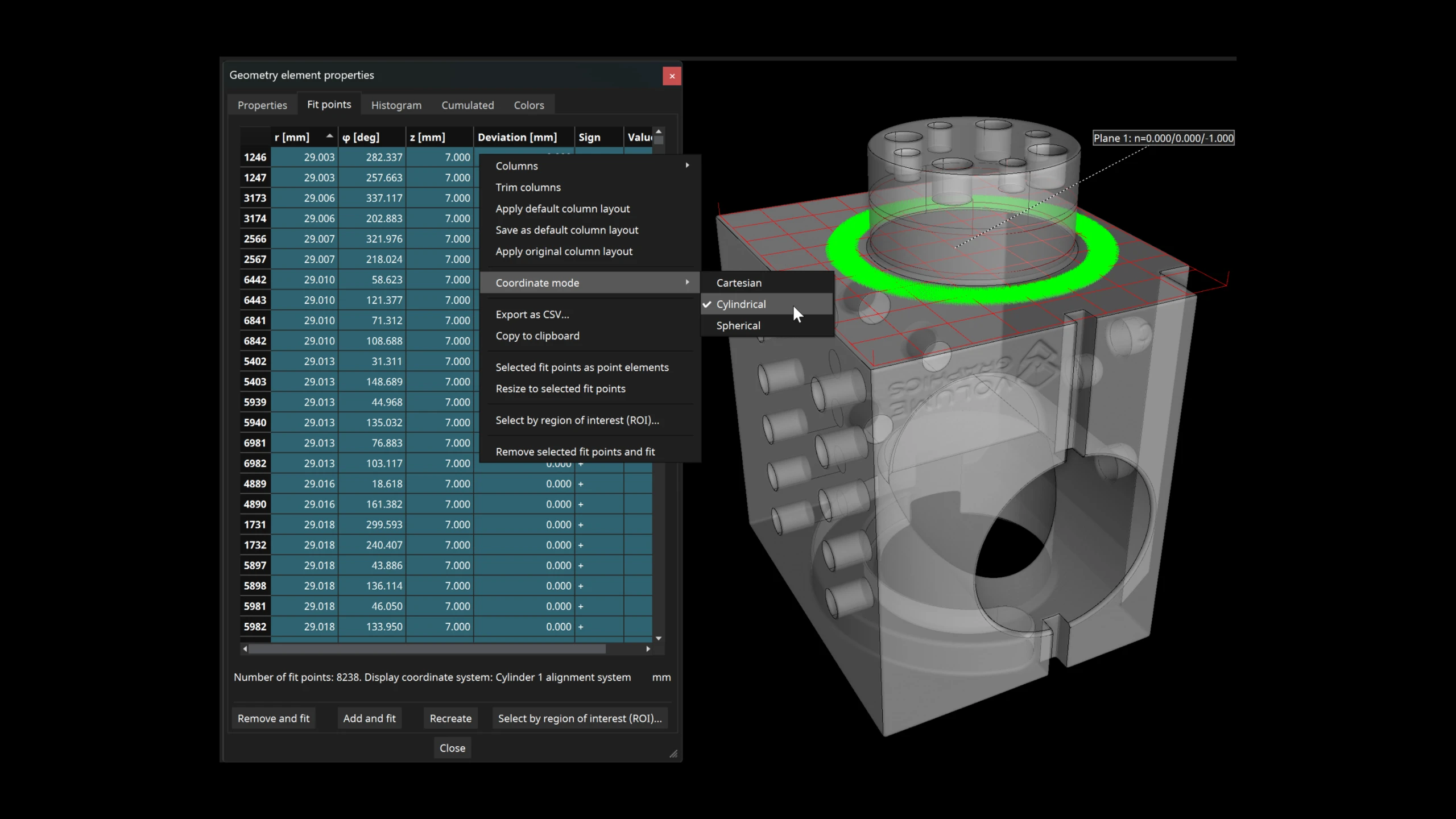
Switch fit point tables to cylindrical or spherical coordinates for rotational symmetric parts, enhancing import, export, and editing processes.
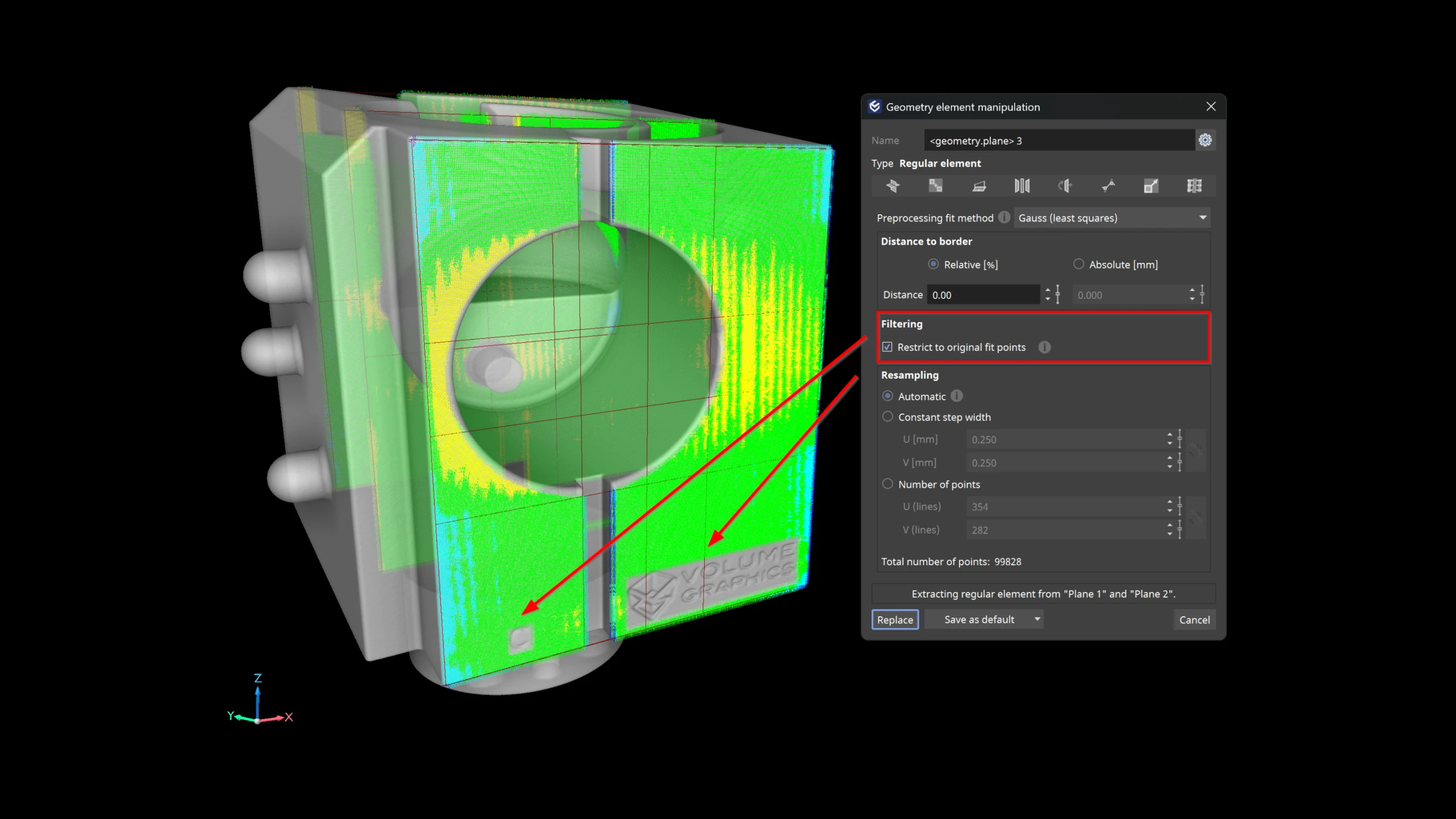
Ensure regular elements only sample fit points in desired areas with the "Restrict to original fit points" option. This avoids sampling in unwanted regions, maintaining accuracy in measurements.

Streamline data processing with the new .xvgi file format, eliminating the need for manual data import. Utilize our Python reference implementation to automate VG software use, even without existing .vgl files.

Focus on actual deviations with auto-scaled color mapping that excludes outliers. This ensures color overlays provide valuable part evaluations without distortion.

The selected color overlay and "Show components only" checkbox are now stored and applied to all automated image generation functions including bookmarks, animations, and object-specific views. This enhances your options for reports and presentations.

Run VG software flexibly on virtual machines using floating licenses, expanding infrastructure options.
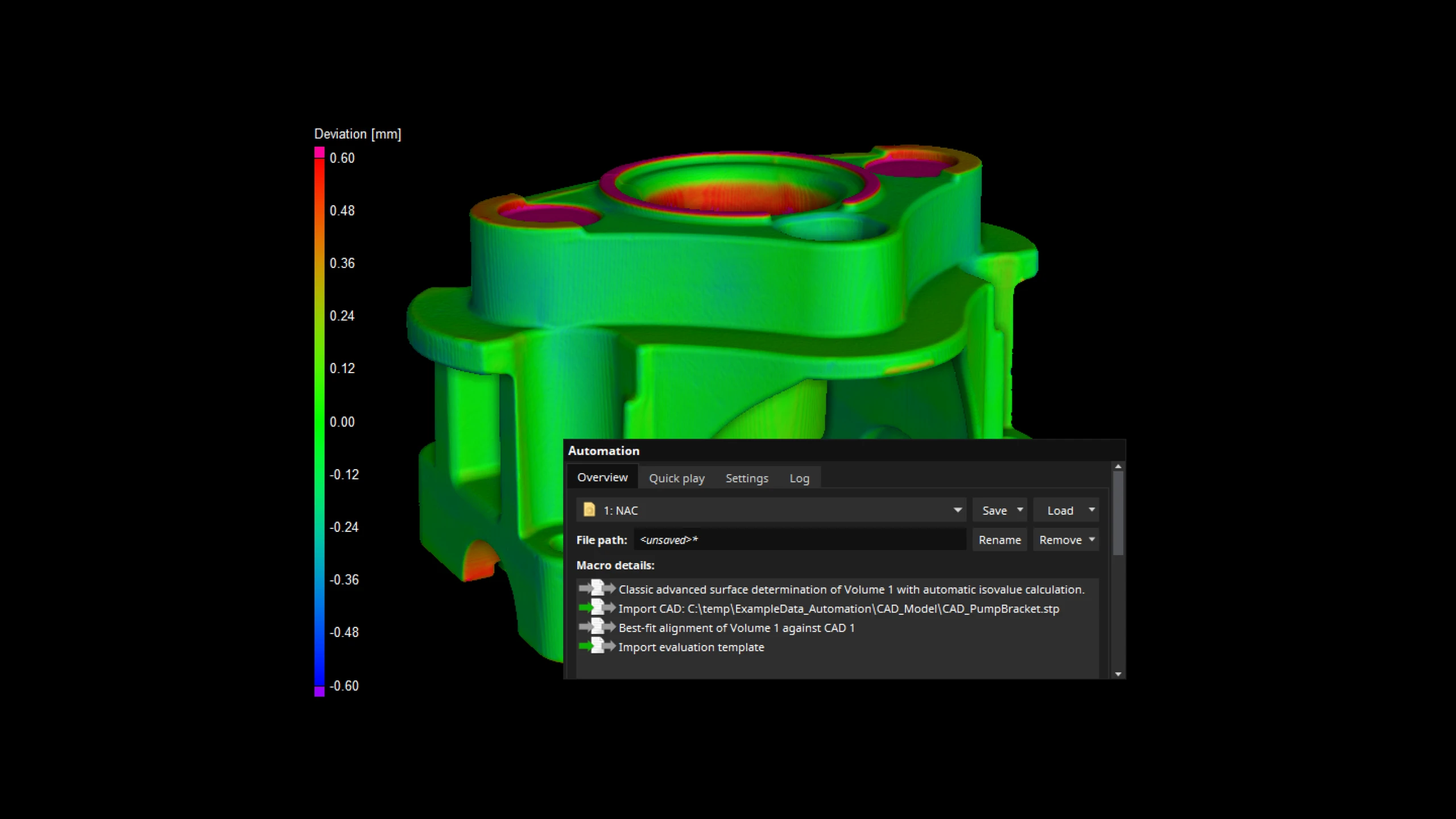
Learn how to speed up your workflows with the "Automation" tool in VGSTUDIO MAX or VGMETROLOGY. Automate part of your workflow by creating macros for single workflow steps, or create an inspection plan, a so-called job, and automate your entire inspection. The job file includes all necessary data for the inspection and can easily be shared with colleagues and customers for its use with other at-line- or in-line CT systems.
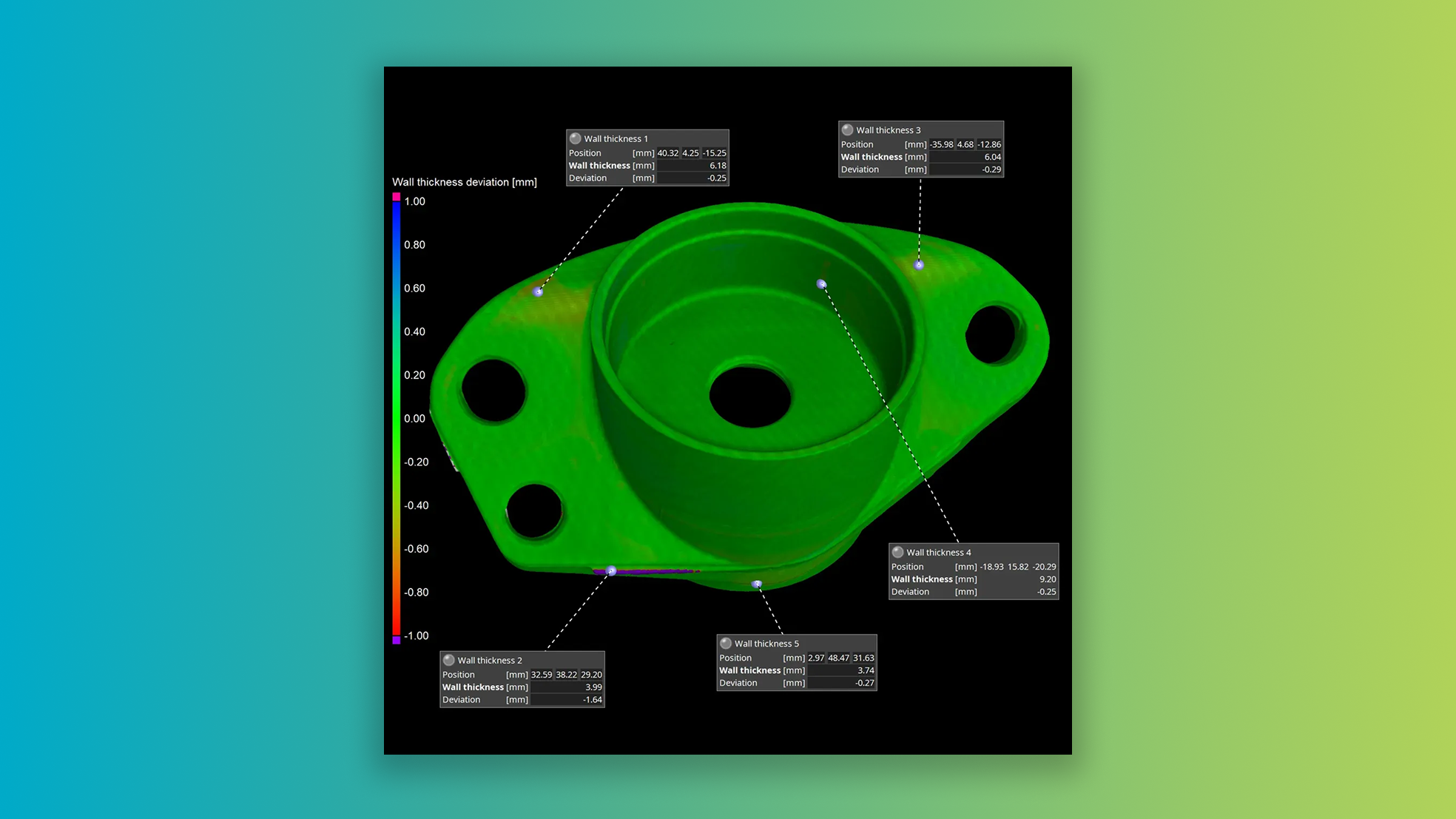
This innovative tool lets you evaluate deviations using percentual values, widening your analysis scope. Benefit from comprehensive insights into your component's stability over a full range of values, including absolute wall thickness, absolute deviation, and percentual deviation from the nominal value. Effortlessly analyze percentual deviations with features like color overlay, histogram, tolerances, and individual annotations.

Q-DAS export for relative wall thickness results
Elevate your data analytics with seamless exporting of toleranced relative wall thickness results in Q-DAS format. Enjoy superior compatibility and integration with the Q-DAS product family.
Easier navigation of PDF reports
PDF reports now also include a table of contents with direct links to the related section of the report. Enhance your user experience and swiftly peruse your reports with this clever addition.

Dive into a whole new interactive experience of creating regions of interest (ROIs) with the "Rectangle 3D" and "Ellipse 3D" ROI creation functions. Straightforward to use, these features let you use simple primitives (rectangle and ellipse) in the 3D view to create volumetric ROIs. Similar to polyline 3D, but without polyline complexity, just click and drag to get your ROI done.

When you move or rotate a region of interest (ROI) or copy it from another object, its mask may not be aligned with the voxel grid of the parent volume. This useful feature allows you to see this status at a glance in the Scene Tree or in the object properties. One click is enough to get the ROI aligned, an action that can also be recorded for automated scenarios.

Peer-to-peer collaboration is now easier than ever! Use the new link in the title bar to hop over to the VG Community on Nexus. Share your wins, get advice, and stay up to date on the latest and greatest in your products.

Introducing a game-changer in deviation analysis: Use your nominal part to tolerance wall thickness deviations on CT scans of the actual part. No more guessing games about wall thickness, no more relying on absolute values of the wall thickness sphere calculation.
Visualize, tolerance, report, and evaluate the real deviations between your nominal part and the actual scan. Leverage our unique adaptive transformation technology to ensure that calculated deviations correspond accurately to surface points on both your nominal and actual parts.
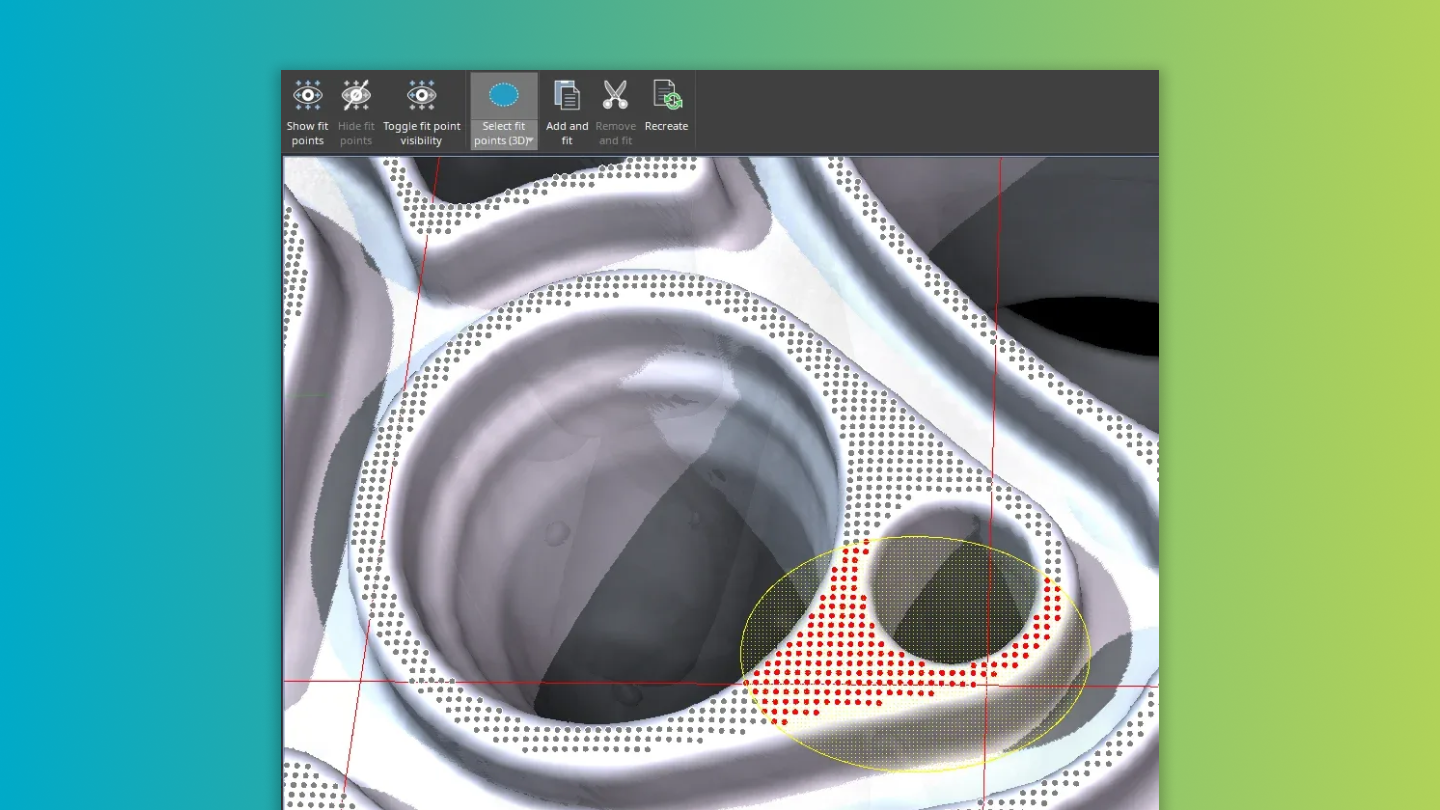
Our new intuitive ribbon tab puts all essential editing tools at your fingertips. You can adjust visibility, make selections, add, fit, remove, or recreate fit points – all from a single hub! No need to search through property dialogs or guess the location of desired fit points. Simply select a geometry element and the tab appears, streamlining your measurement plan adjustments.

Selecting objects is more intuitive than ever: Just pick your tool of choice — rectangle, ellipse, or lasso – and directly draw in the 3D window. As soon as an object’s center of mass is highlighted, the object will be selected in the Scene Tree. Add or remove objects directly in the 3D window – WYSIWYG.
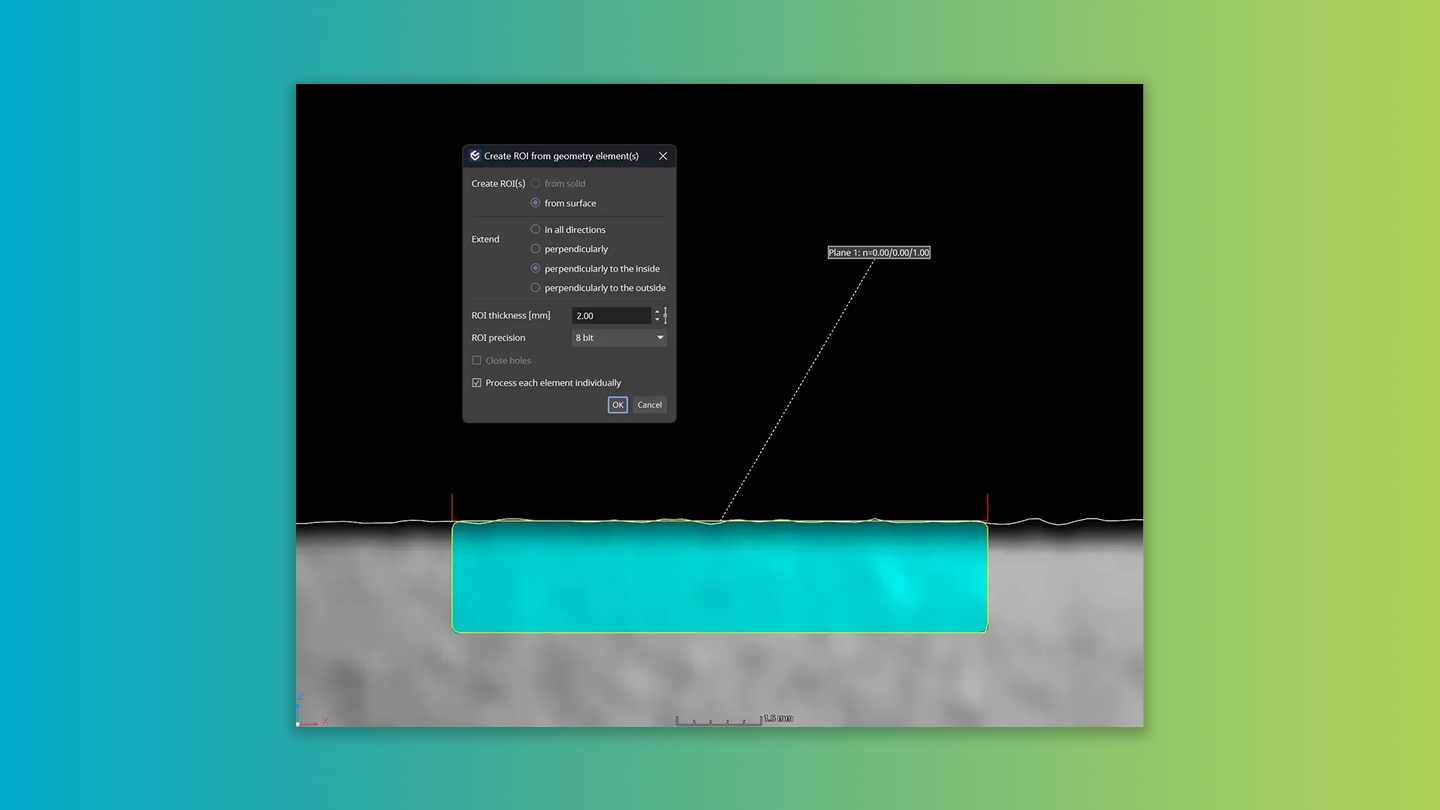
You can now create ROIs with a defined thickness from the surface of ideal geometries, making it simpler to streamline ROI creation for various analyses, including P 203. Choose from various expansion modes: in all directions, perpendicular to the surface, or exclusively to the inner or outer side based on the surface orientation.

Enable or disable ROI rendering for numerous objects simultaneously! Enjoy better automation scenarios, with the toggle macro step now distinctively separated into two clear steps: "Enable ROI rendering" and "Disable ROI rendering". This ensures better reproducibility of macro jobs for a more streamlined user experience.
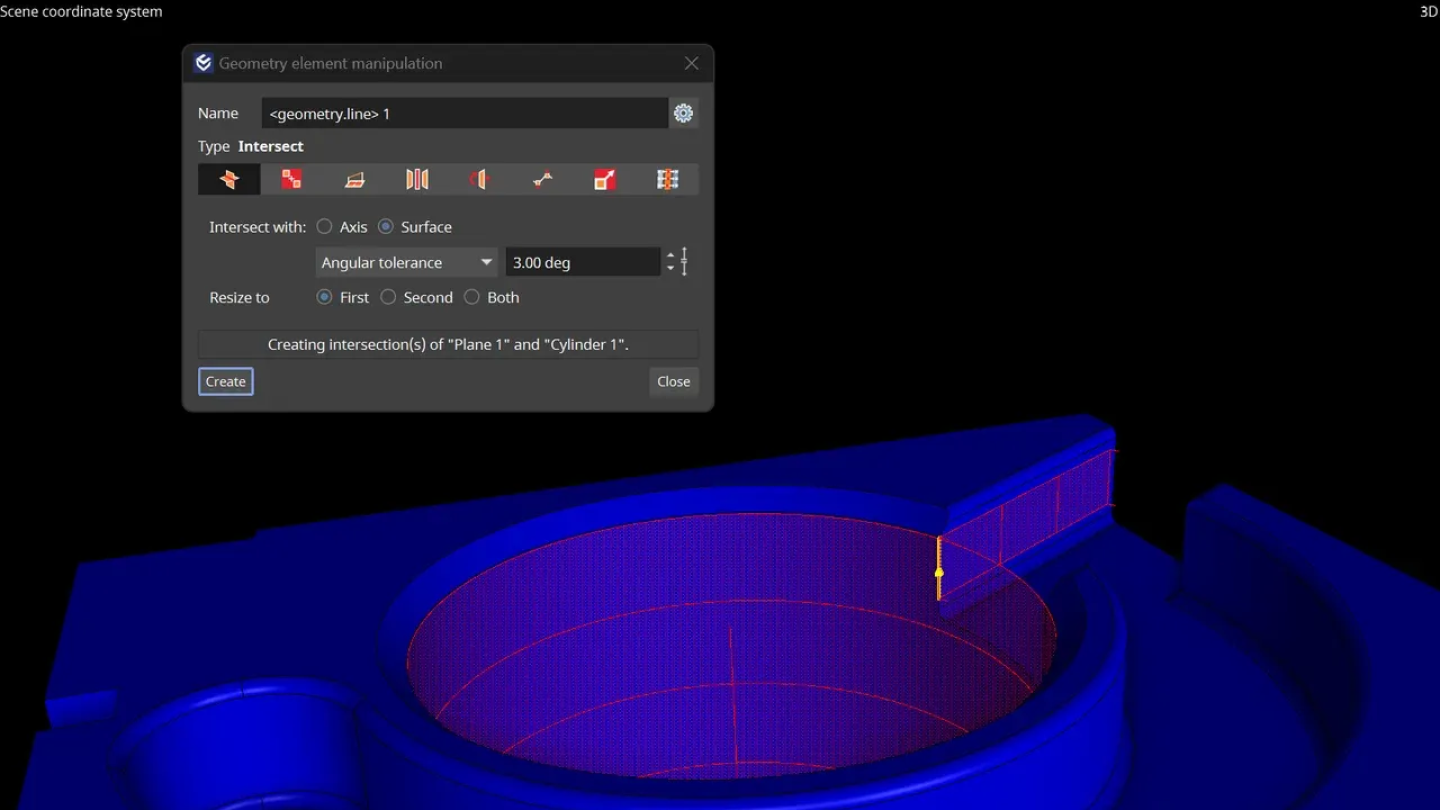
Say goodbye to those pesky workarounds! You’re now able to create an intersection line with the desired size directly between the shell of a cylinder and a parallel plane.
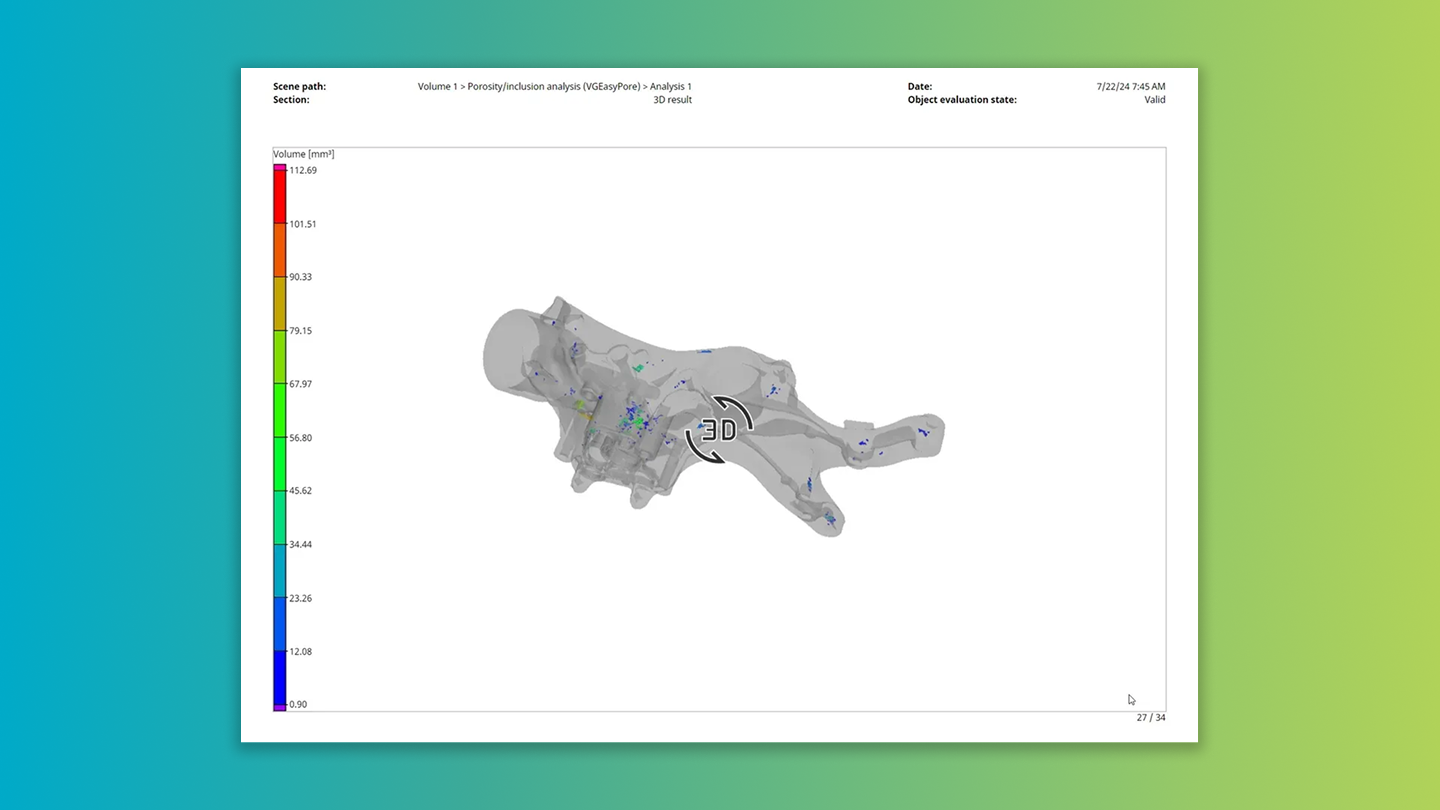
This dynamic feature utilizes the color bar settings configured directly in the analyses, offering an enriched context to interpret results in your reports. Elevate your reporting experience and data interpretation capacity with this unique update.

Color-code table cells in reports according to their tolerance state
You can now opt to color-code individual cells based on their tolerance status. This instant visual representation not only enhances the meaning of your result tables but also allows for quicker identification of specific indicators that caused a part to be out of tolerance. A more meaningful, intuitive understanding of your data is just a color away!
Hide info field names in reports
You can choose to hide the title of any info field in your report. This feature not only allows for seamless integration with any personalized text but also contributes to creating more succinct report pages. Enjoy more control and design freedom with our refined reporting settings.
Invalidation of bookmark images on analysis changes
Bookmark images are now tagged with an "out-of-sync" status if analysis results change. For automated scenarios, all "out-of-sync" images undergo an automatic update before saving, ensuring that the bookmark images reflect the current state of your project accurately. Experience improved visibility and control over your data with this dynamic update.
Rename objects using metainformation
You can now rename objects using one of their metainformation fields. Ideal for use in macros, this function can transfer text read from an object via OCR to its name in automation scenarios. Experience elevated control and efficiency in your data management with this latest feature enhancement.

Enhance your efficiency with our latest multi-threaded mesh simplification feature! Whether you're converting a volume to a mesh or preparing 3D data for reporting, this new implementation drastically reduces the number of triangles in a surface mesh and significantly accelerates calculation times. Step into a smoother, faster computation experience with this innovative update.

The well-known feature in VGSTUDIO MAX is now also available for users of VGMETROLOGY.

This upgrade radically reduces the time spent browsing for macros in your file system. Enjoy a smoother, more efficient workflow and let us handle the heavy lifting. Work smarter, not harder!
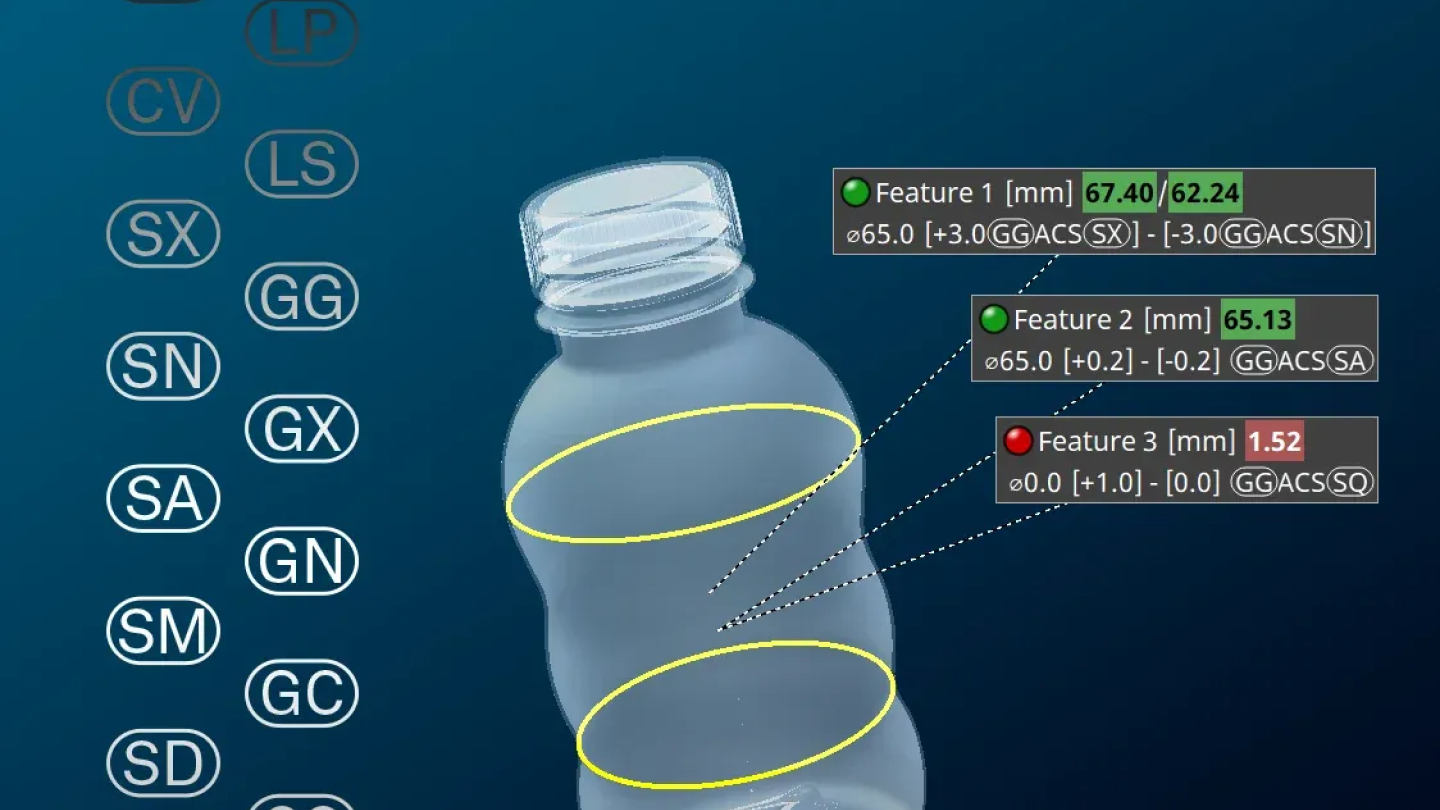
You can now measure linear sizes that require the use of rank order modifiers (for example, for the calculation of an average size) or the use of the ACS (arbitrary cross-section) modifier for the calculation of size measurements in any cross section.
Measurement tasks according to ISO 14405-1 that require the use of these modifiers can now be easily performed by choosing the appropriate modifier symbols in the "Linear sizes" dialog.
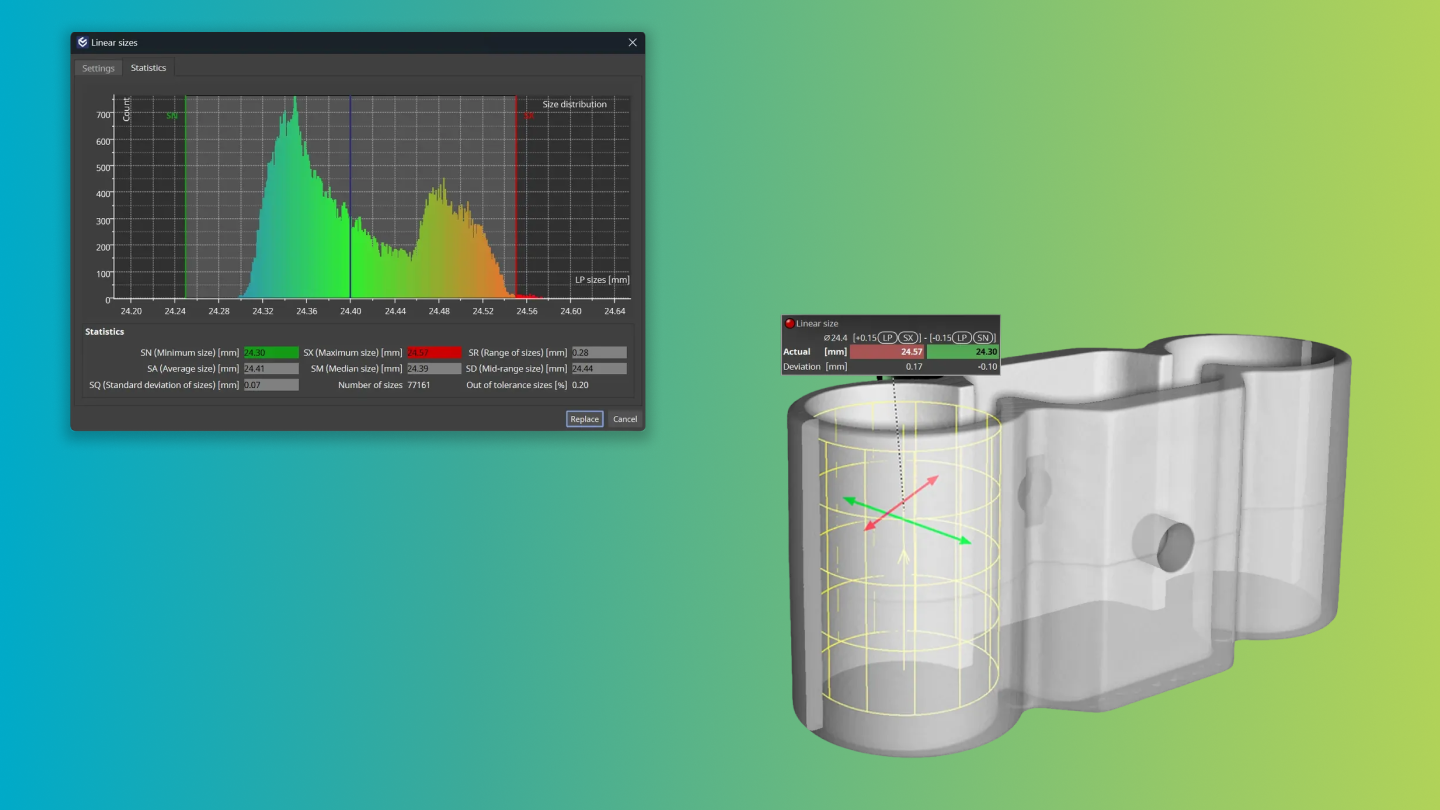
When you use linear size modifiers such as LP (local two-point size) or ACS (arbitrary cross-section), many sizes will be calculated at a time. While you will usually tolerance only a single size value (e.g., the maximum, SX, or the minimum, SN), much more information about the measurement itself is now available: A new tab in the "Linear sizes" dialog will show you a histogram of all calculated sizes as well as a number of statistical values, allowing for an intuitive overview of the size distribution and overall tolerance state of the measured element.

The advanced CAD import with PMI is now capable of interpreting modifier symbols of linear sizes and automatically creating the appropriate linear size measurements during import.
Additional import options allow you to choose the default modifier symbols to be used when linear sizes without specific modifier symbols are found in the PMI data.

You can now create regular elements for circles and two parallel opposing lines in a 2D view and use them for linear size measurements and various geometric tolerances. This is especially useful when you have to measure linear sizes in a specific cross section (SCS) of an element.

Customizable text color in reports
We further enhanced the customizability of reports: you can now set arbitrary colors for all textual layout elements to highlight certain results or custom text.
Exporting multiple movies or image stacks of an inspected component at a time
The new queuing function of the "Save movie/image stack" dialog allows you to parameterize and queue multiple export jobs, and subsequently export all image stacks or movies at a time without further interaction.
This will streamline your export process considerably, as you will no longer have to wait for the completion of each individual export job before being able to parameterize and start the next one.

The new explanatory texts will make it easier for users to understand the purpose and functionality of both the "Bookmark" and the "Automation" tool and improve the accessibility of the software.

The computation of deformation fields can now be automated via macro. This way, you can save time in your daily work when using deformation fields for the “Morph mesh” or the "Compensation mesh" function, or for adaptive ROIs or coordinate measurement templates.
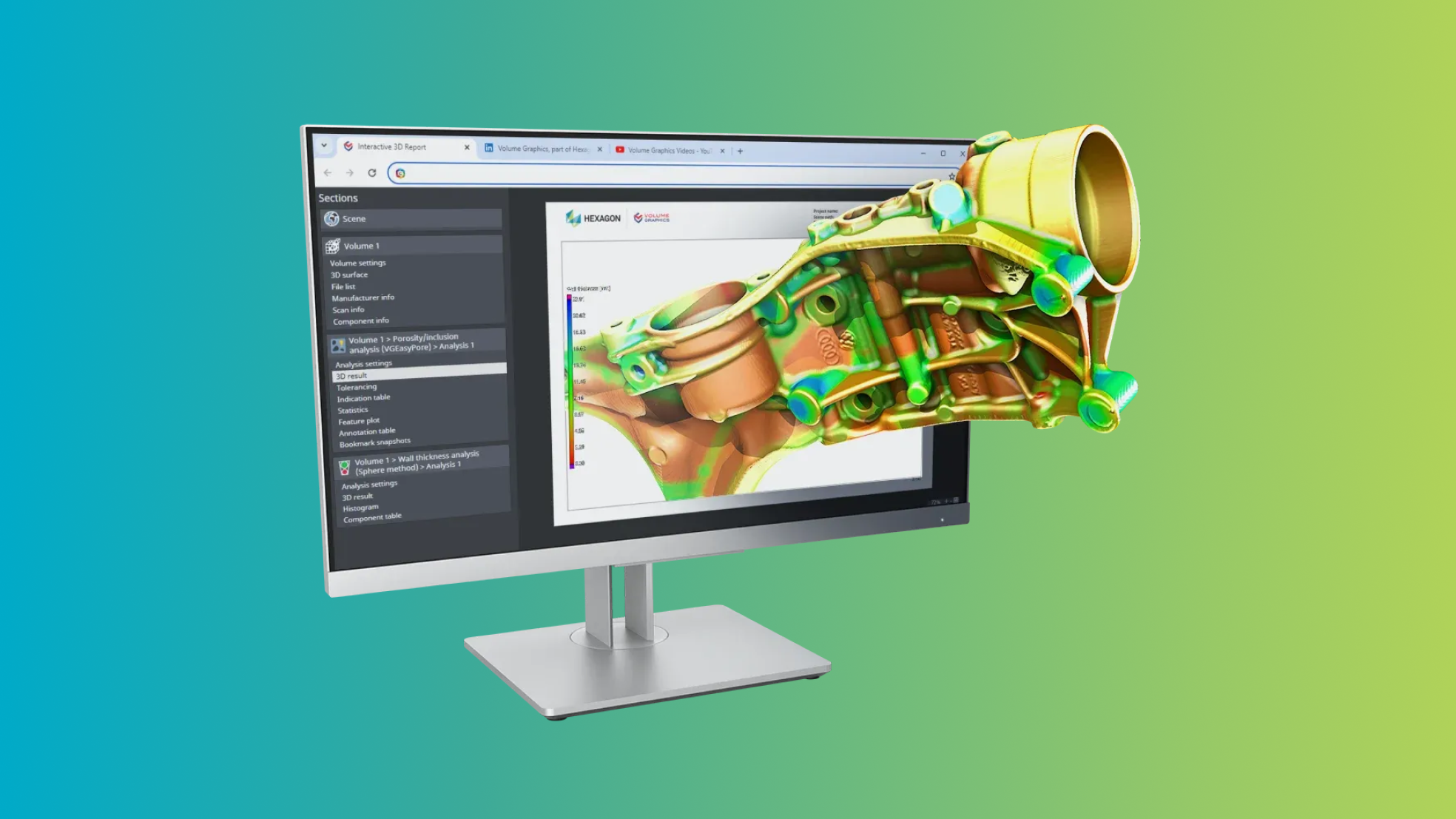
Sharing comprehensive inspection results just became even easier. The new HTML format is an all-in-one solution that also supports interactive elements, like part or result 3D views. These self-contained documents eliminate the need for a separate viewer application and are easily accessible with any Chromium-based browser like Edge or Chrome.

Simplify standard conform measurements with direct support for modifier symbols. These include two-point measurements [LP], the envelope requirement (E), and global modifier symbols like [GG], empowering easy evaluations for many size features.

Now, projects loaded during batch processing won't automatically clutter your recent files list. This ensures your manually worked-on projects remain readily accessible. However, if you prefer the previous setup, don't worry — you can always change this setting in Preferences.
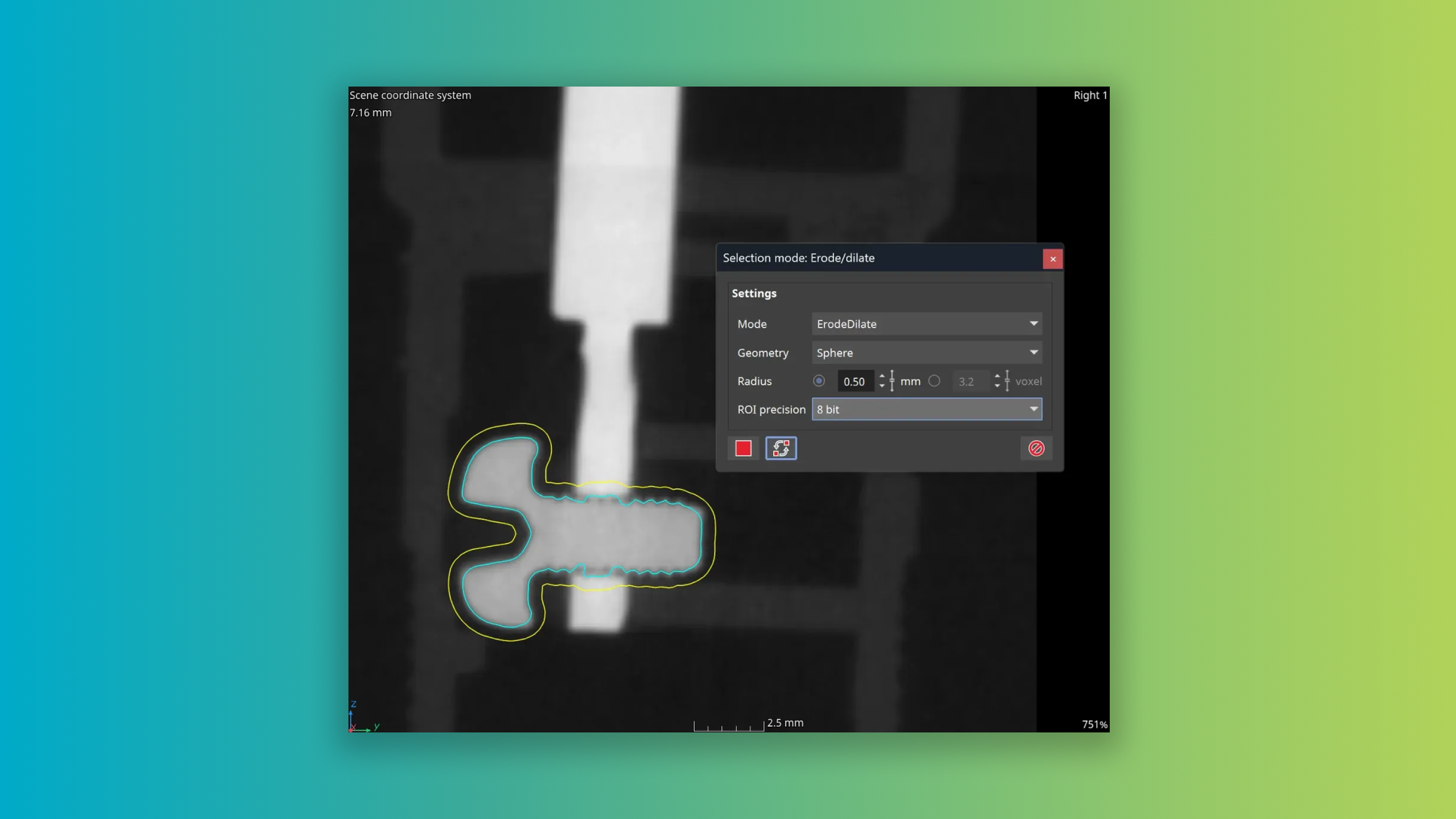
You can now specify the sphere radius in length units, even on anisotropic data sets. Enjoy significantly boosted performance, reaching computation speeds that are more than 50 times faster — specifically noticeable when utilizing larger radius values.

PNG format for streamlined image stack import and export
You can now bypass the need for additional file conversions when using PNG as a storage or data exchange format. Enjoy a faster workflow for importing and exporting your volume data.
New DICONDE export
Volume data can now also be exported in the DICONDE format, which includes the existing tags. For volumes that were not imported from DICONDE, the necessary tags are created on the fly.
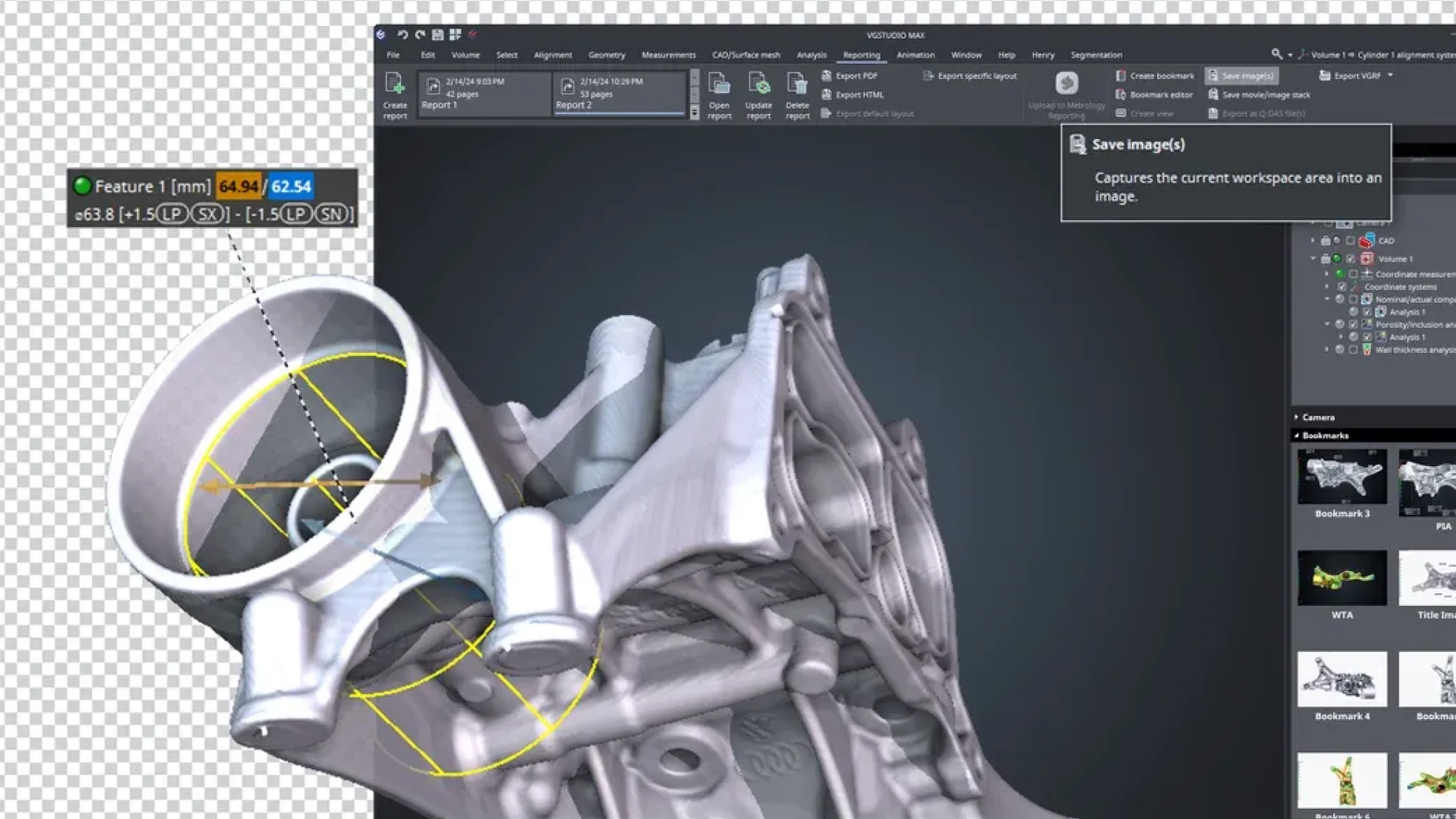
Experience better image saving capabilities with native PNG format support, our new feature allowing lossless compression and 3D view images that include an alpha channel. Spice up your presentations with partially transparent images that pop!

In the past, transferring metainformation like DICONDE tags between different volumes in a scene was impossible. With this feature, you can now easily move this essential information, even when creating entirely new volumes from initial scan results. This enhancement ensures traceability is maintained throughout your process, keeping your work consistent and structured.
Read the basic requirements below or download the PDF for the complete system requirements for VGMETROLOGY.
Windows 11 Enterprise 64-bit
Windows 11 Professional 64-bit
Minimum: x86-64 CPU with instruction set SSE 4.1. ARM processors are not supported.
Recommended: Performant Intel or AMD multi-core processors, e.g., Intel® Core™ i7 or i9 or Xeon® Gold processors with 3 GHz or higher.
Minimum:
VGMETROLOGY requires a minimum of 4 GB of free memory. However, the actual free main memory needed for creating or loading a complete project might be significantly higher since it depends on the data set size, the number of objects per project, the analyses to be performed, and whether the import function will be used.
Recommended for professional use:
- If your tasks include importing CT data sets without advanced surface determination, the free main memory should at least be 2.5 times the size of the data set to be imported. If your computer has less free main memory, the import will be performed block-wise, which, however, will reduce performance. Be aware that block-wise processing during import is not available when the Filter components (particles) or Filter voids option is used.
- If your CT data sets already have an advanced surface determination (automatically from prior import into VGMETROLOGY or prior processing with VGSTUDIO MAX), use File > Open instead of File > Import. Importing CT data sets is not available in VGMETROLOGY ES or VGMETROLOGY VIEWER. The amount of data when opening a project is usually relatively small and can be handled by any state-of-the-art off-the-shelf computer. However, if a project contains many data sets, the memory requirements will be increased accordingly.
- Typical for industrial use is a PC with at least 64 (for one data set) to 512 GB RAM (for multiple data sets), depending on your workflow. Higher RAM clock speeds are recommended.


